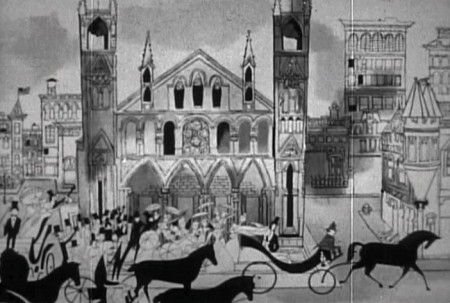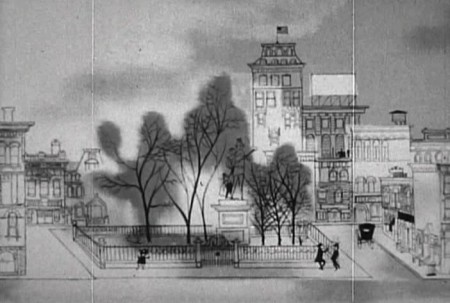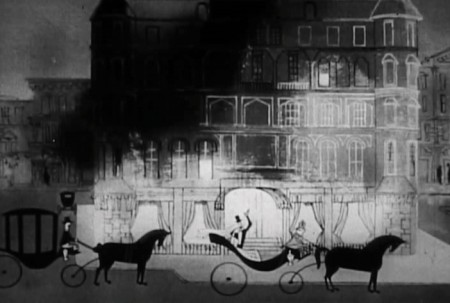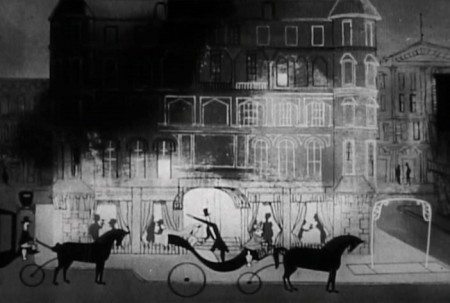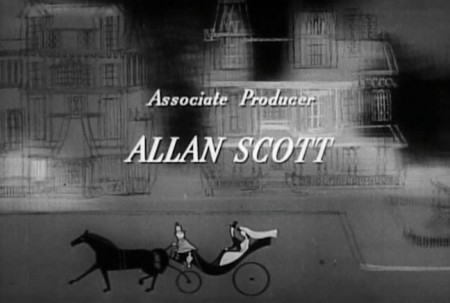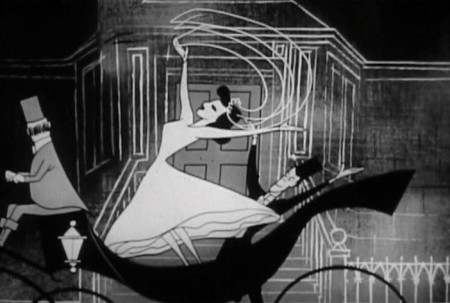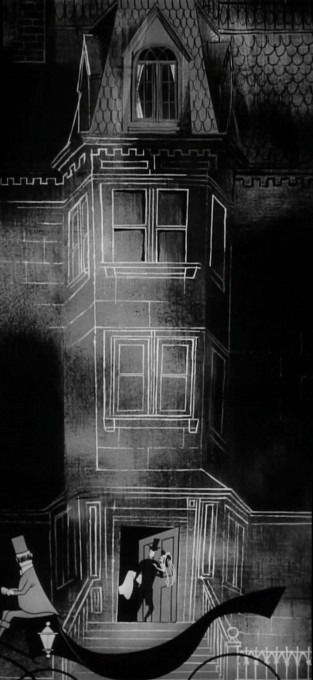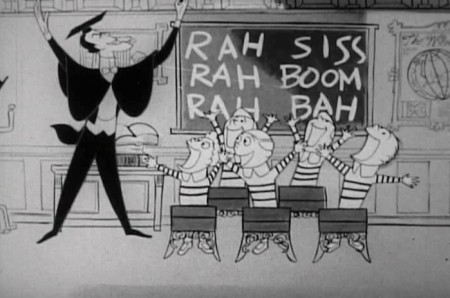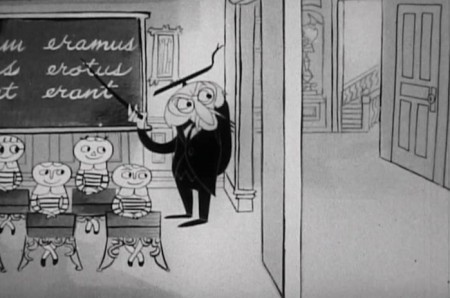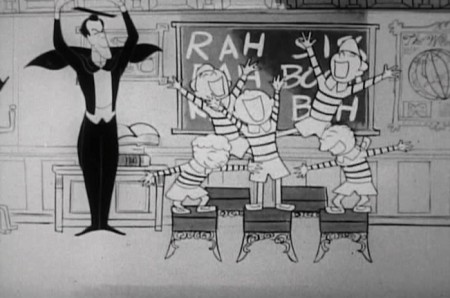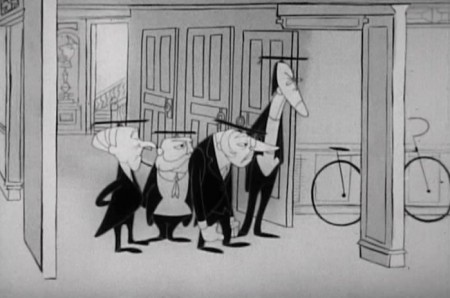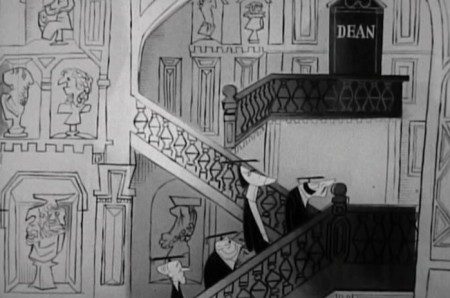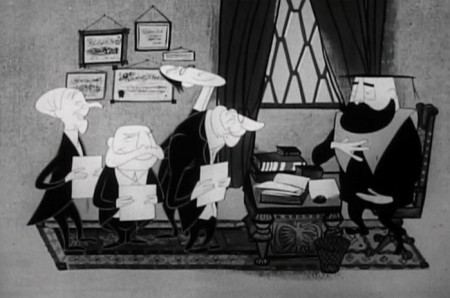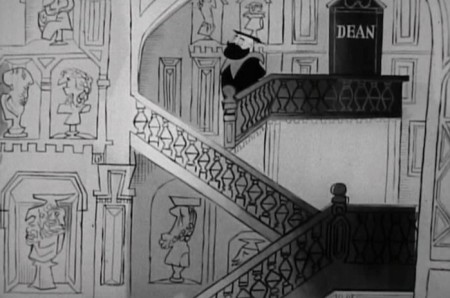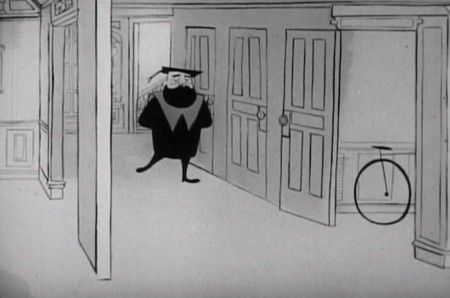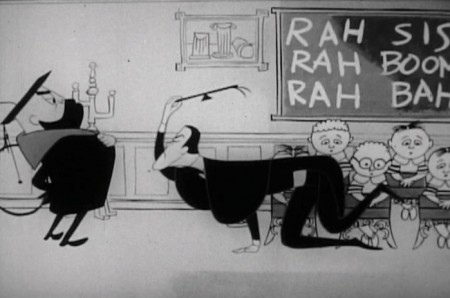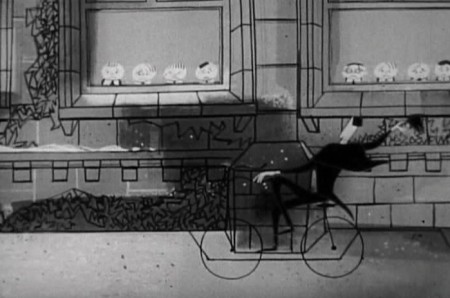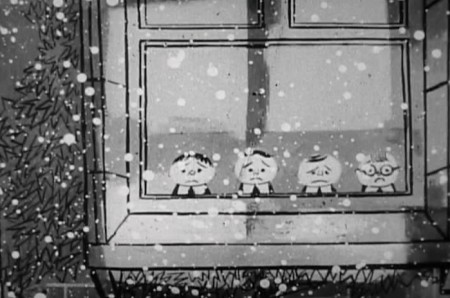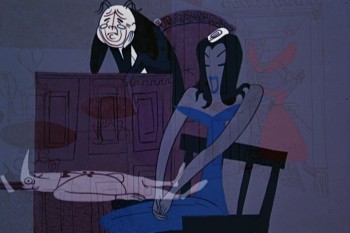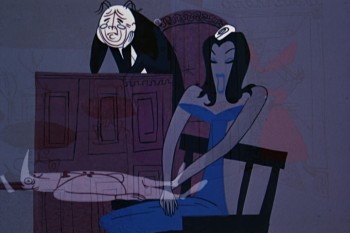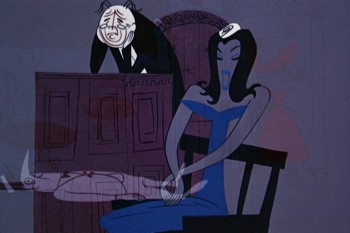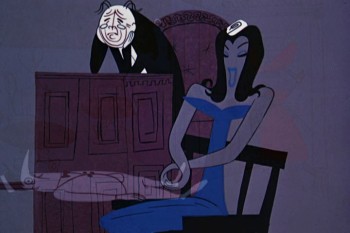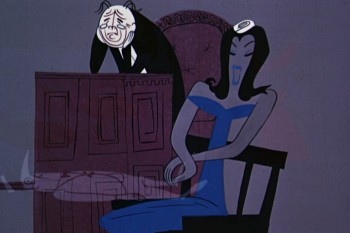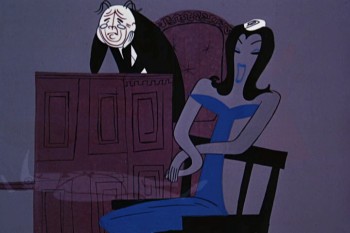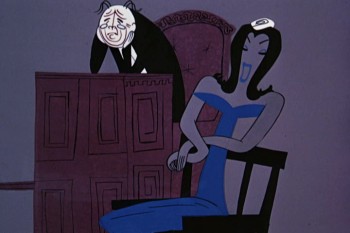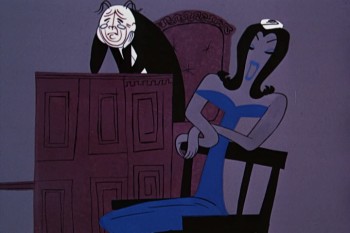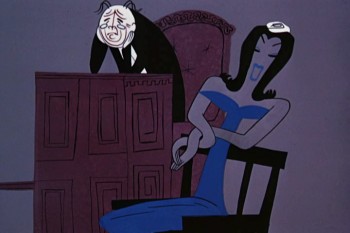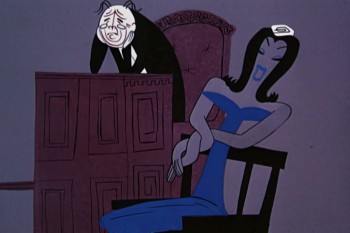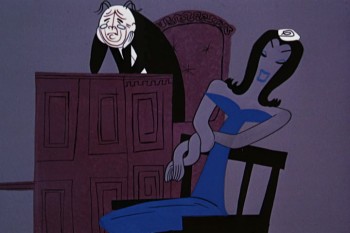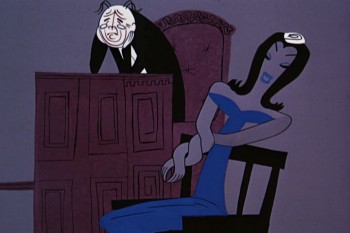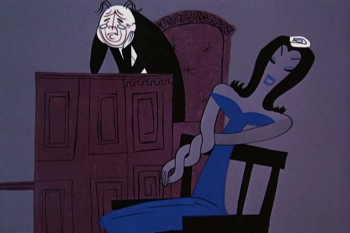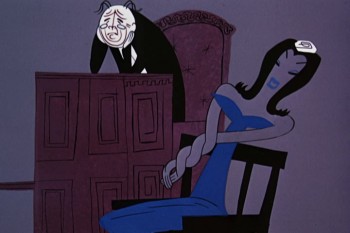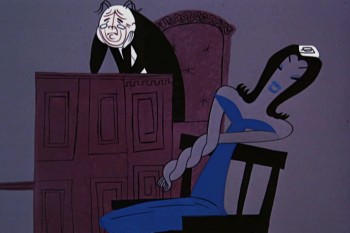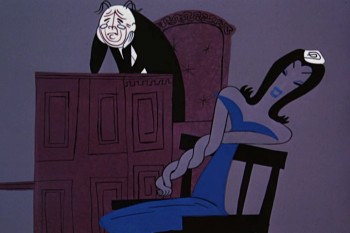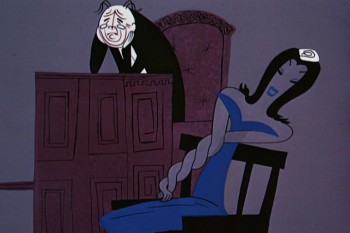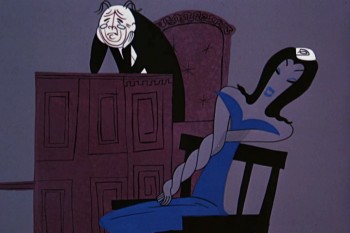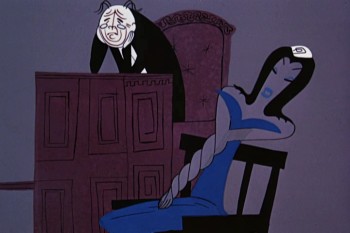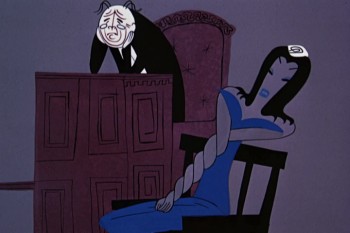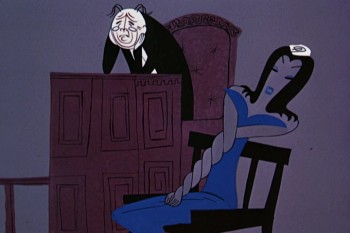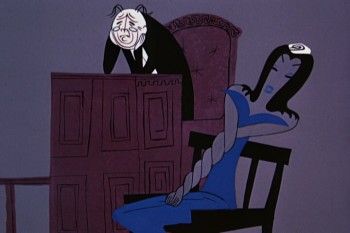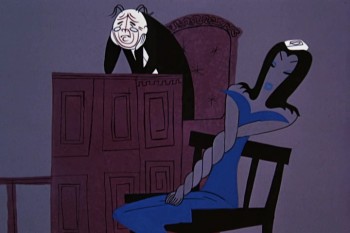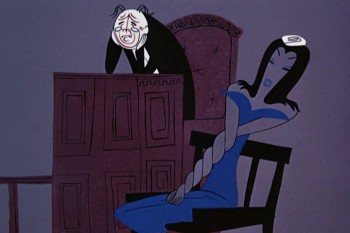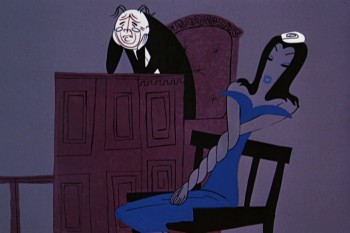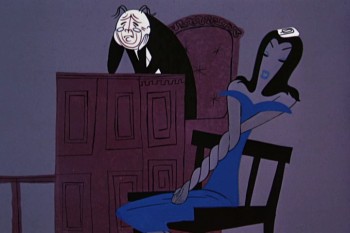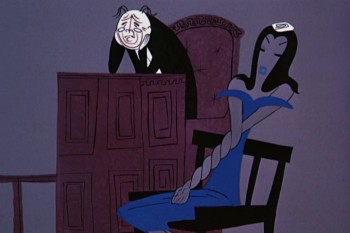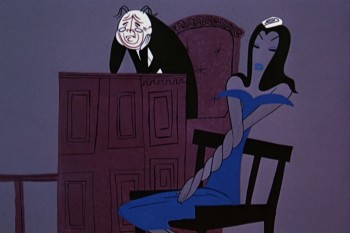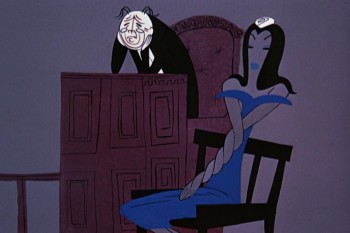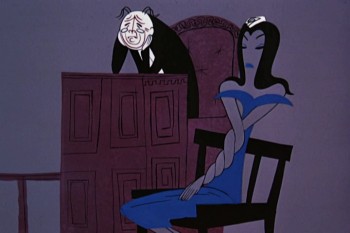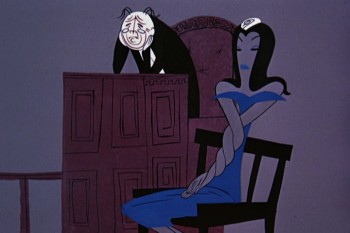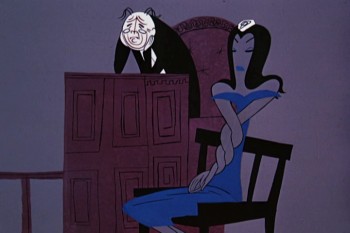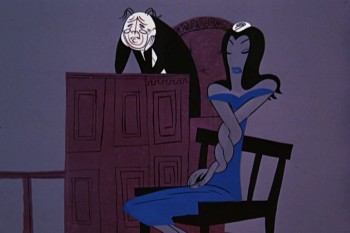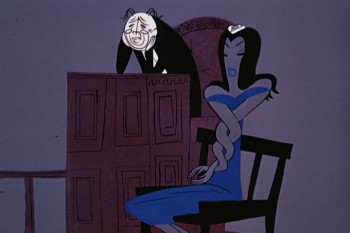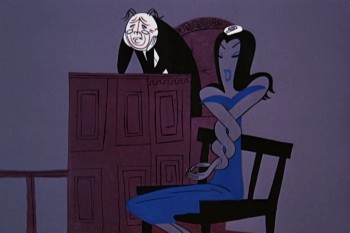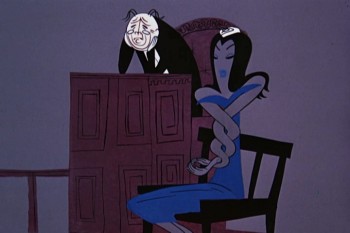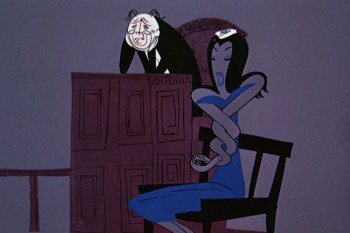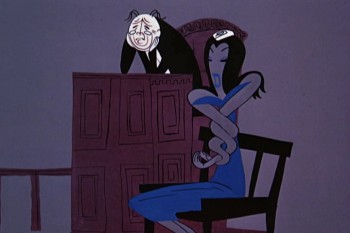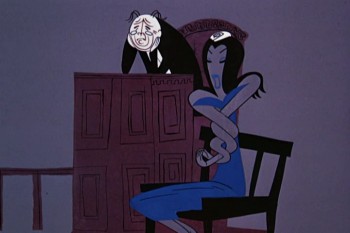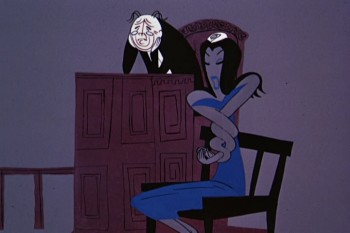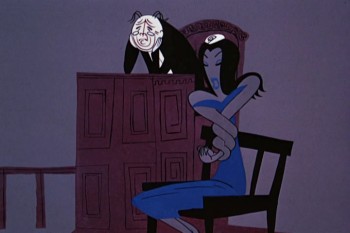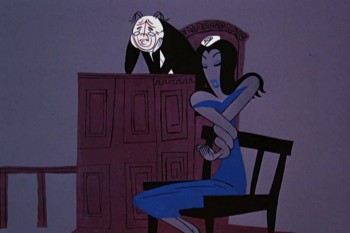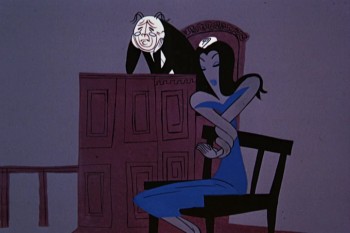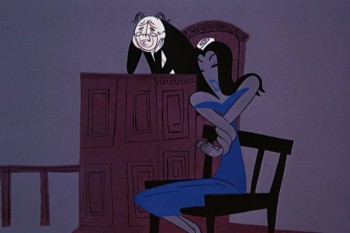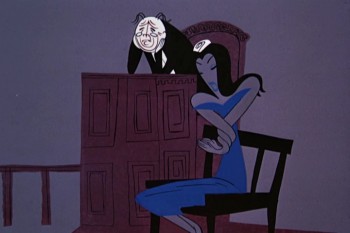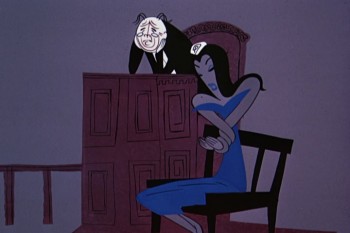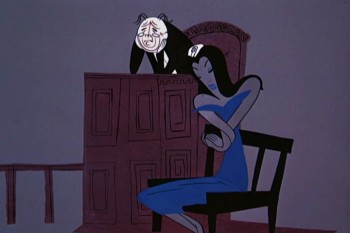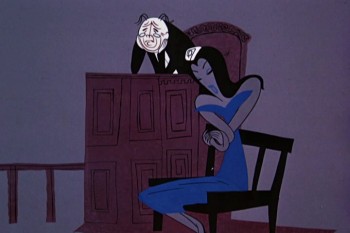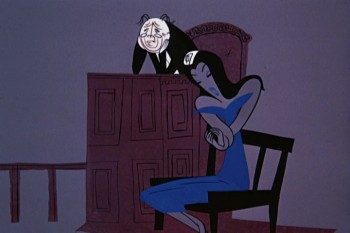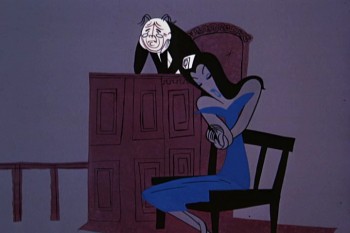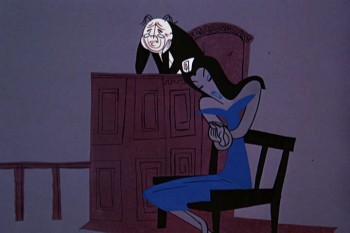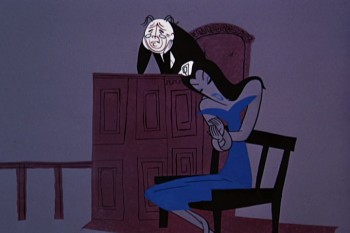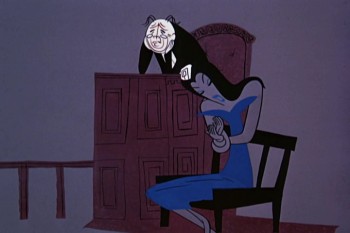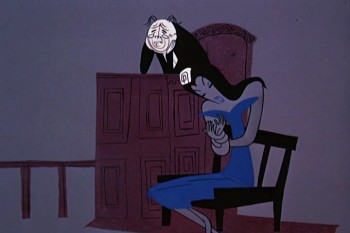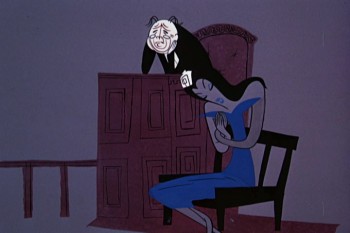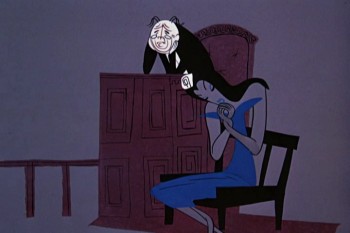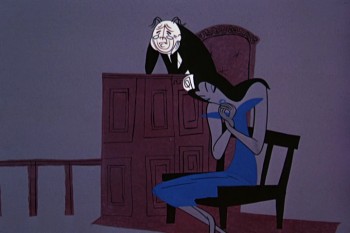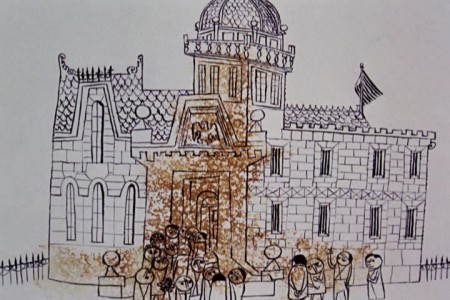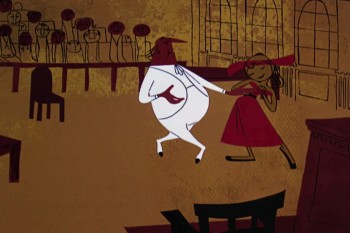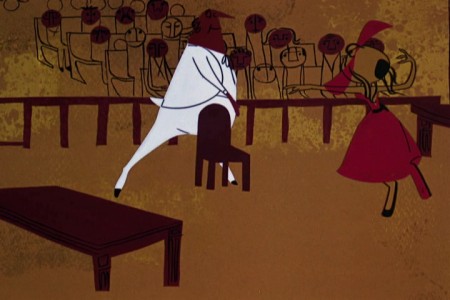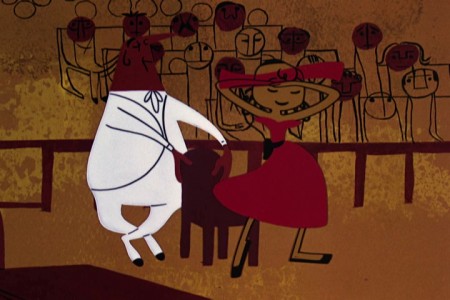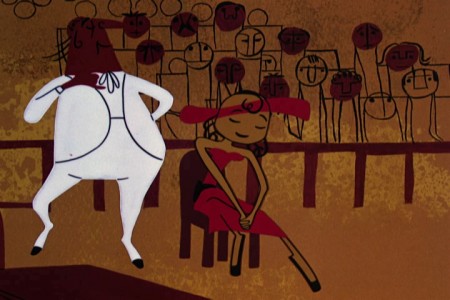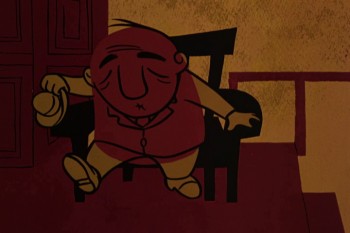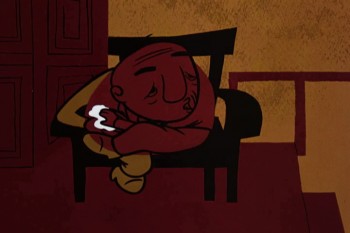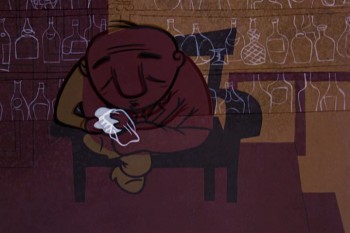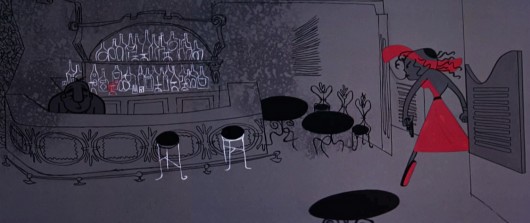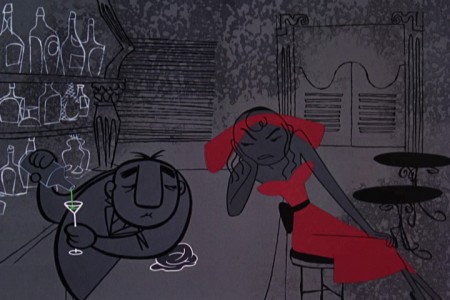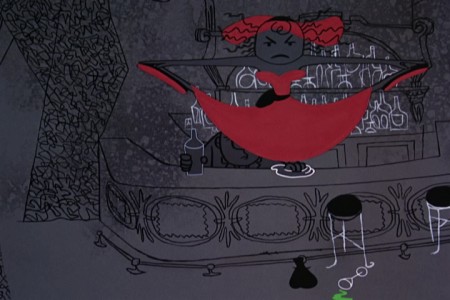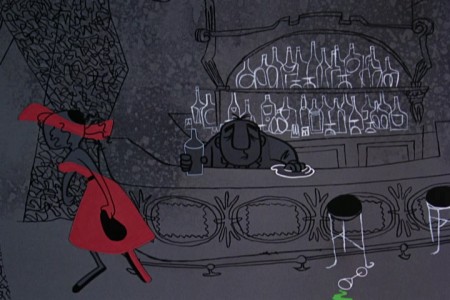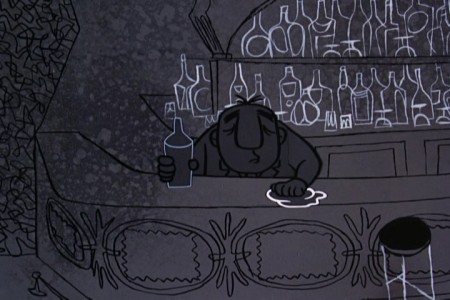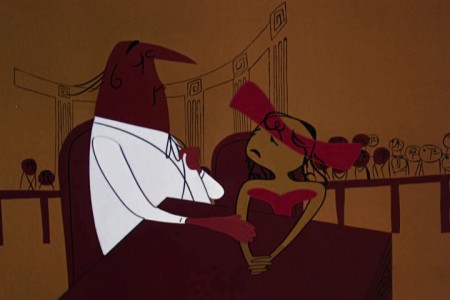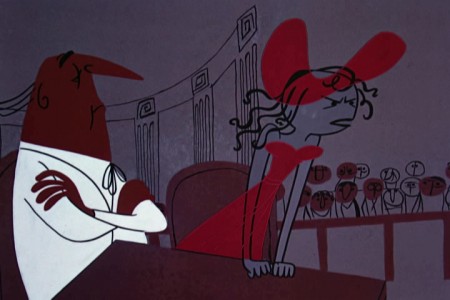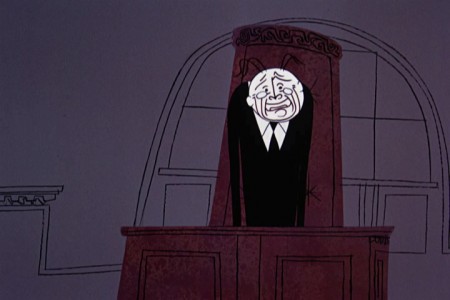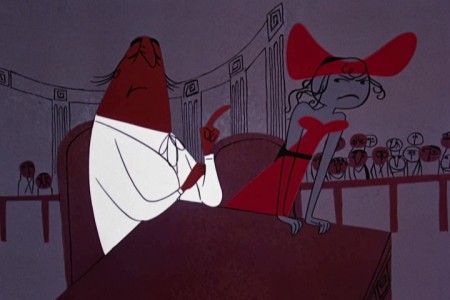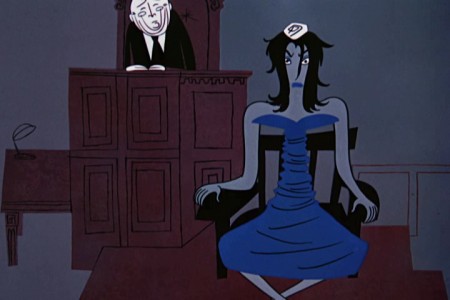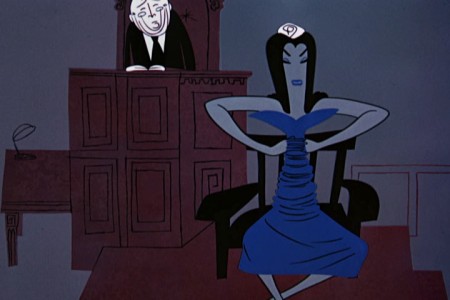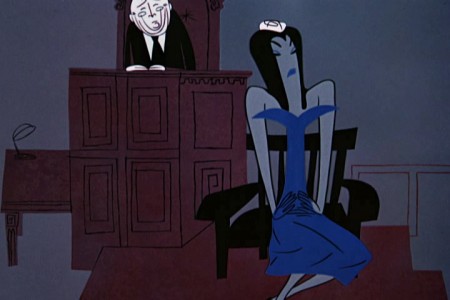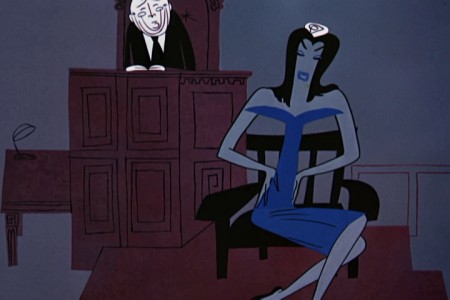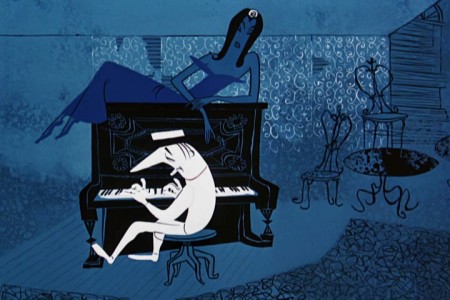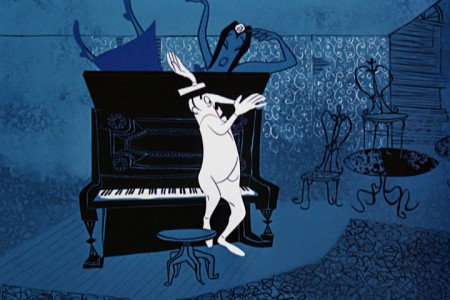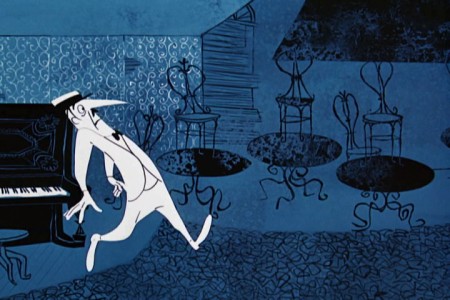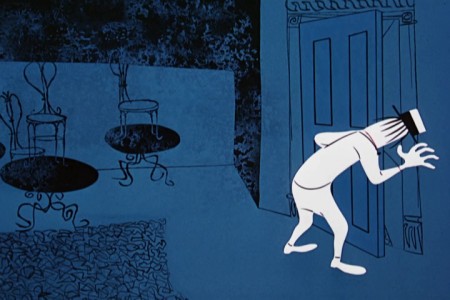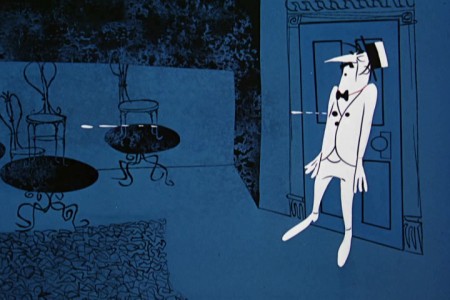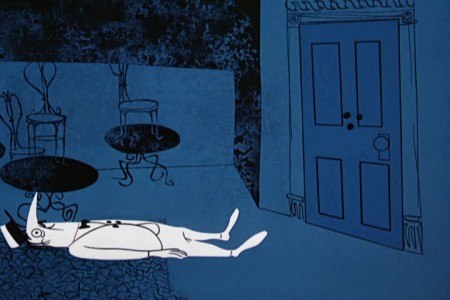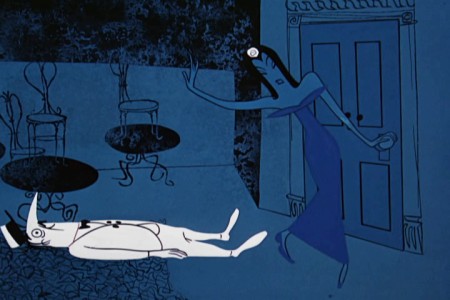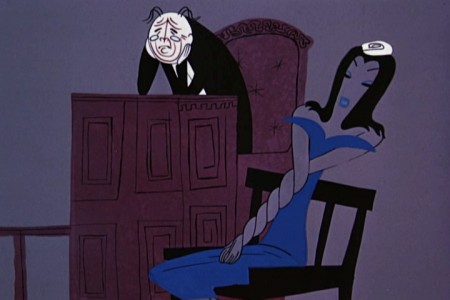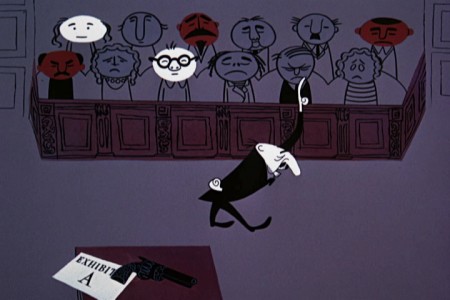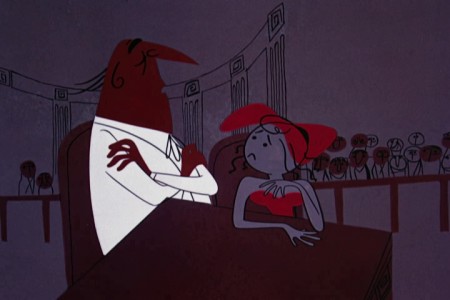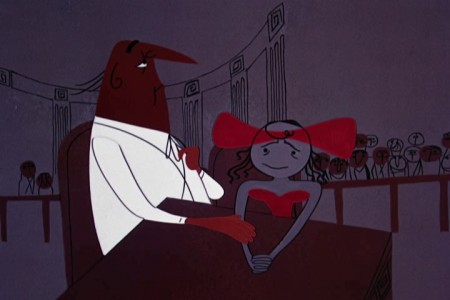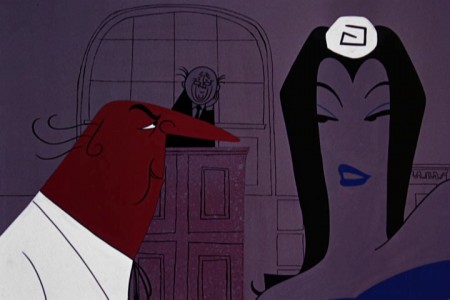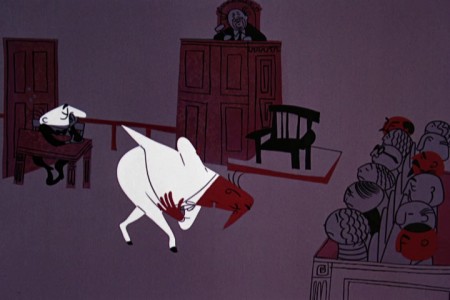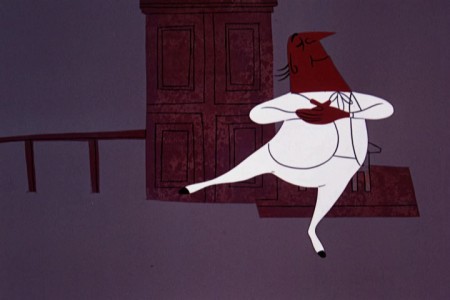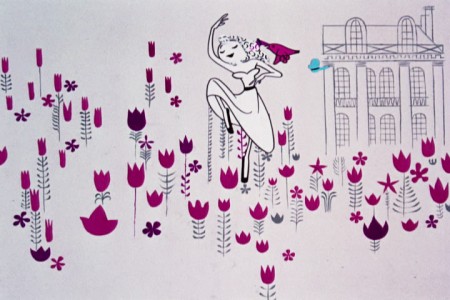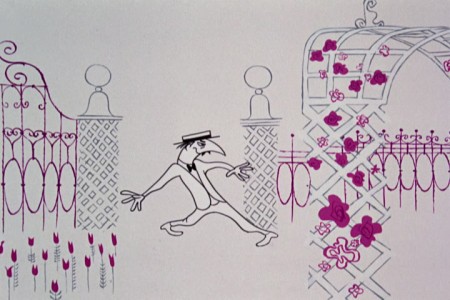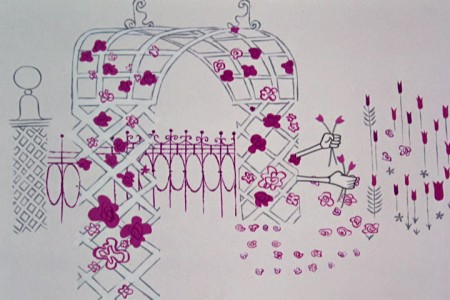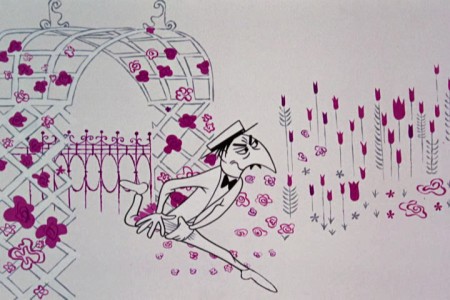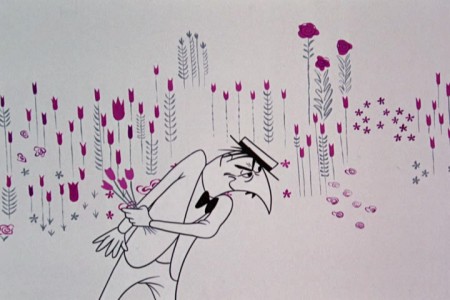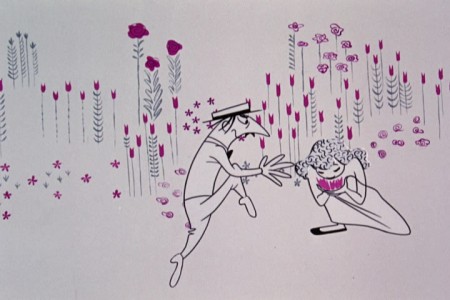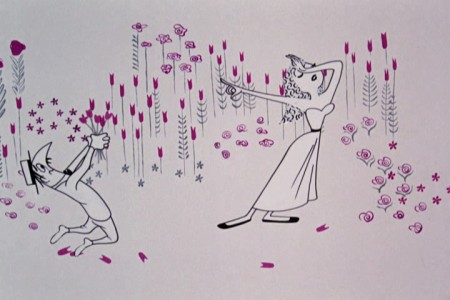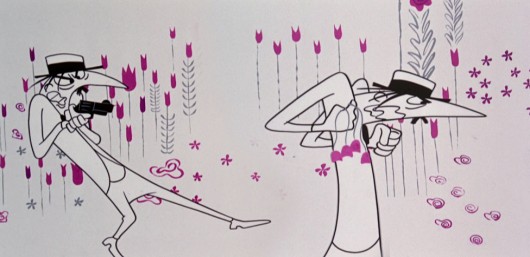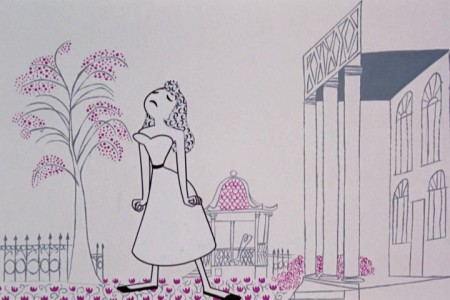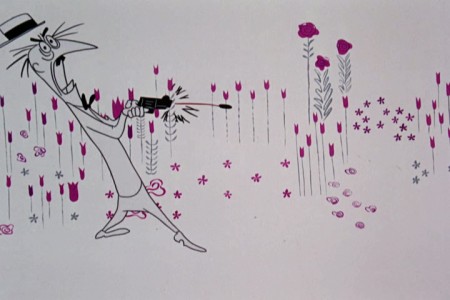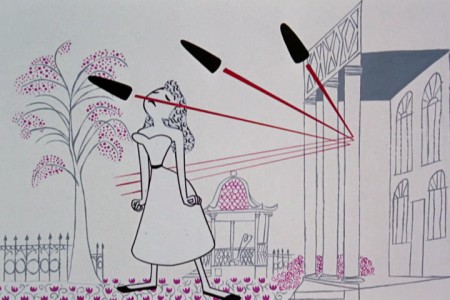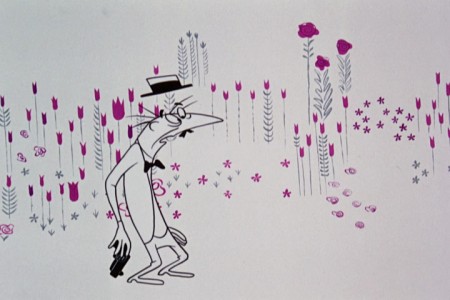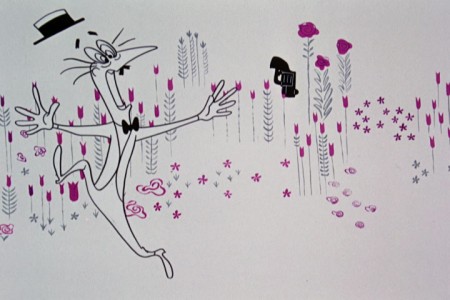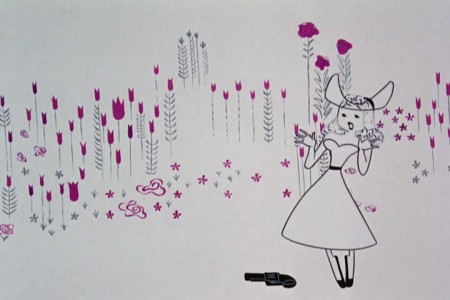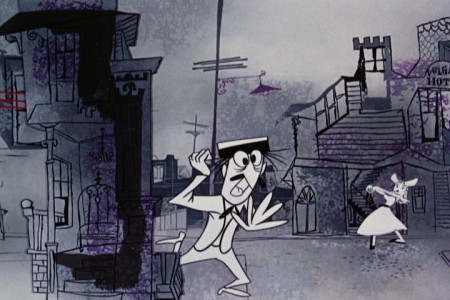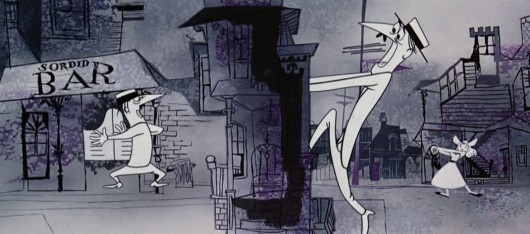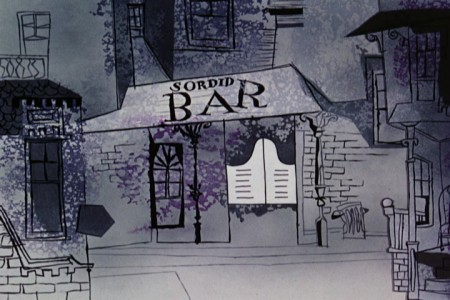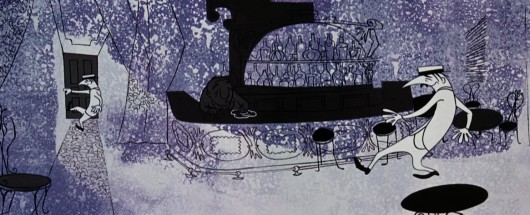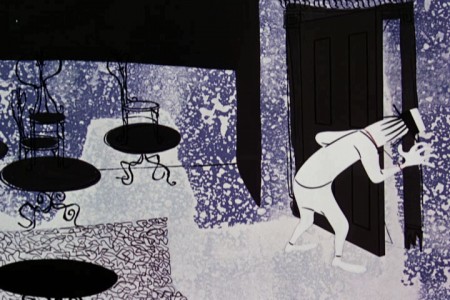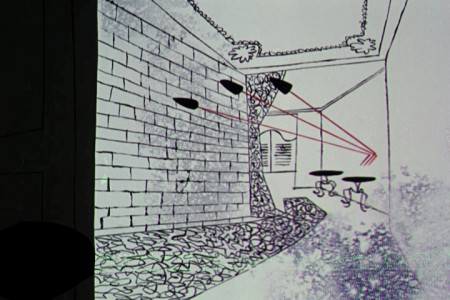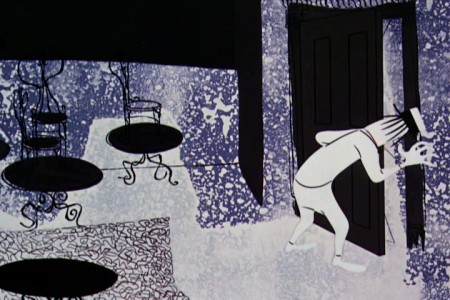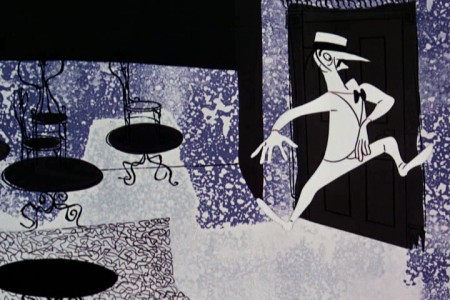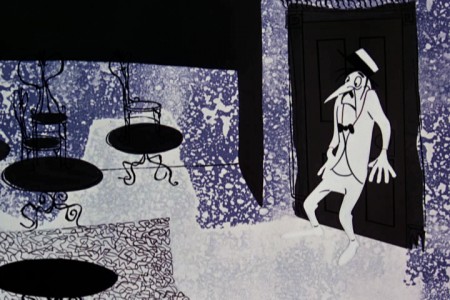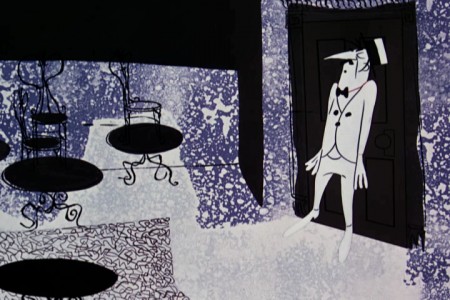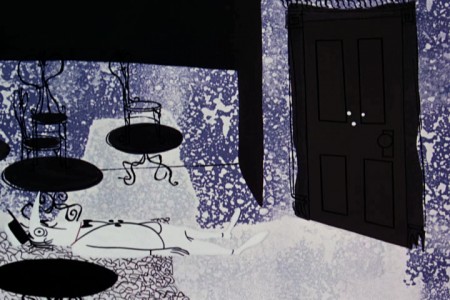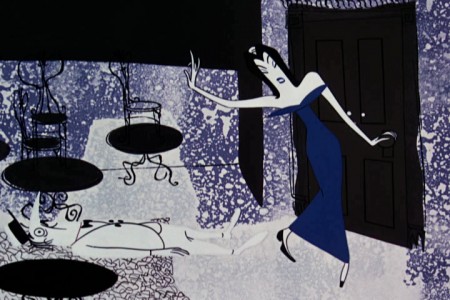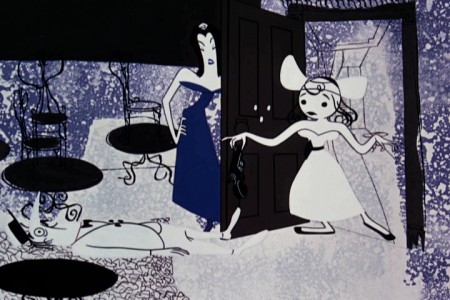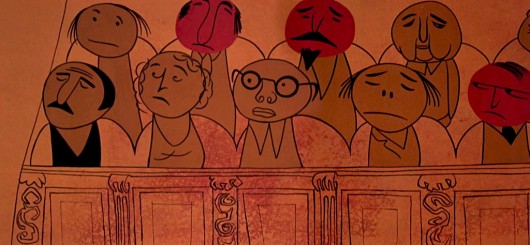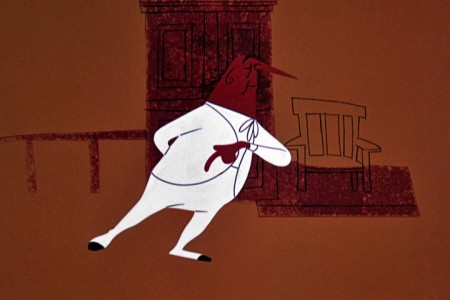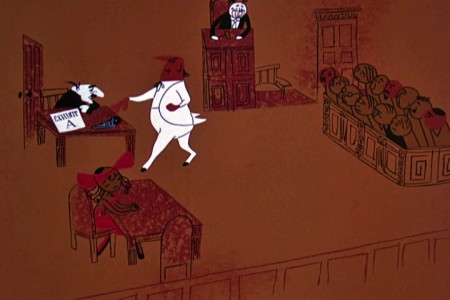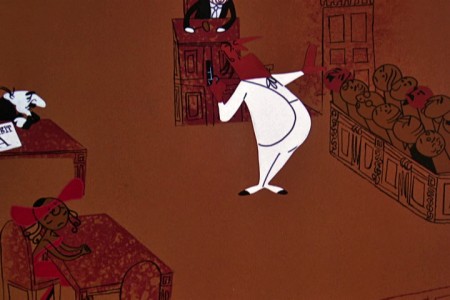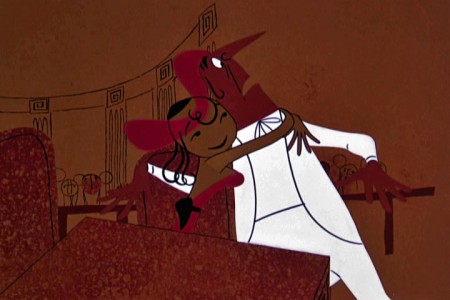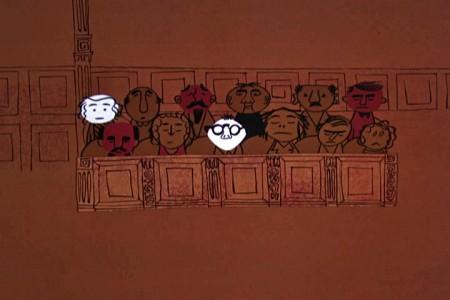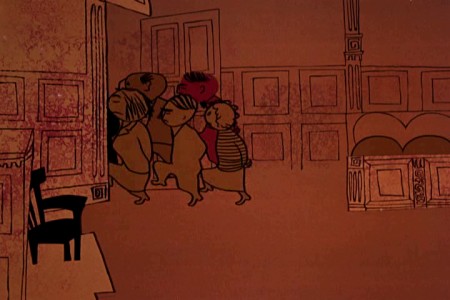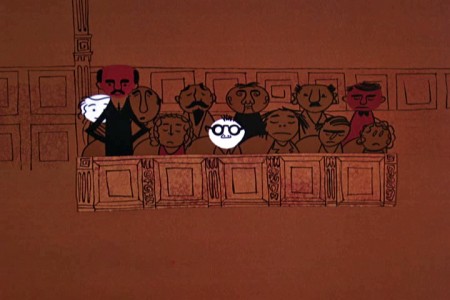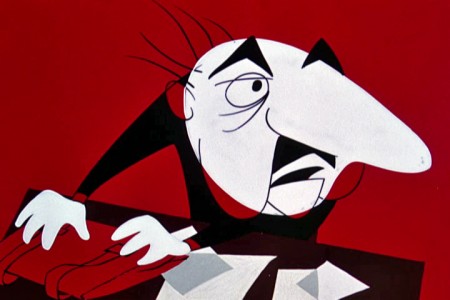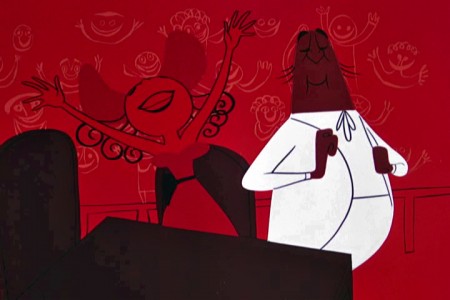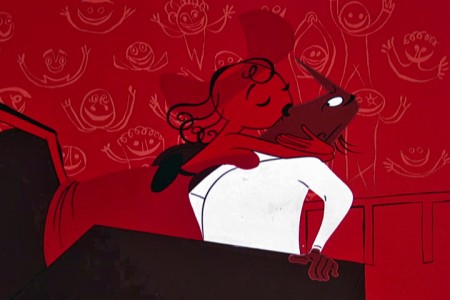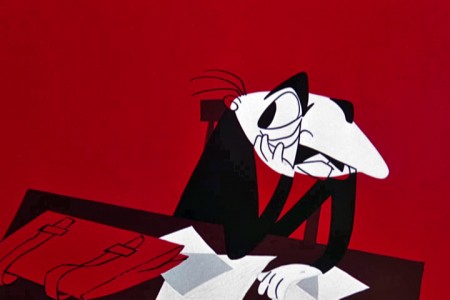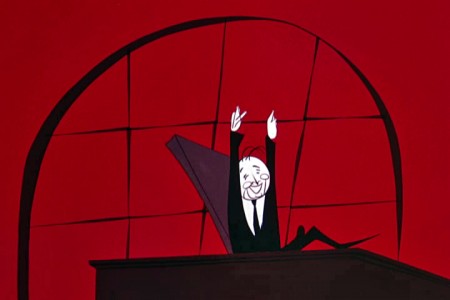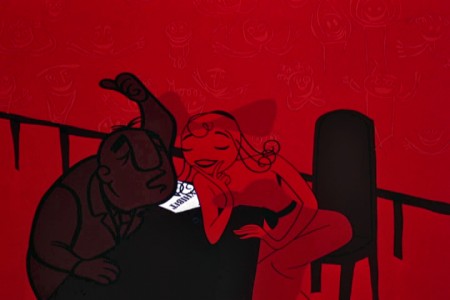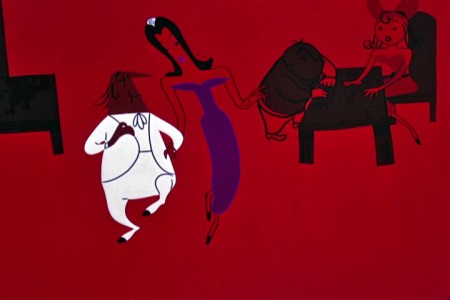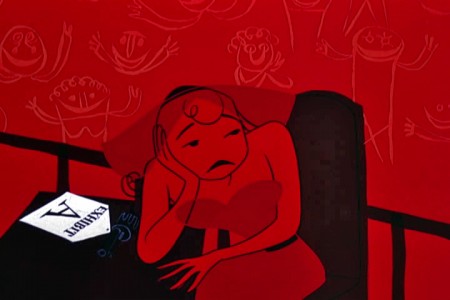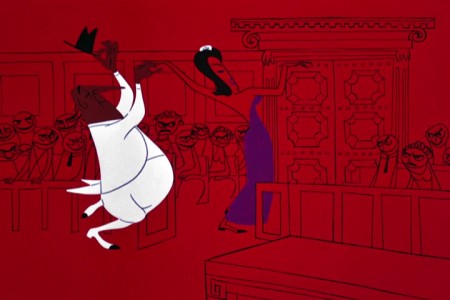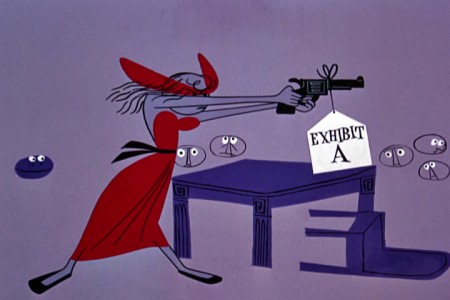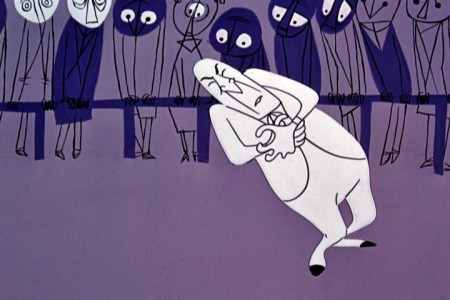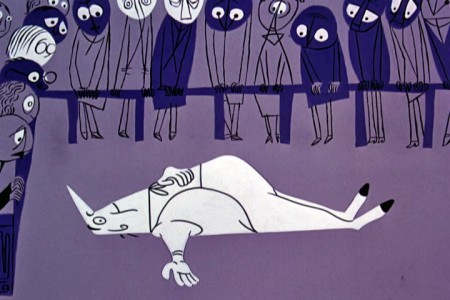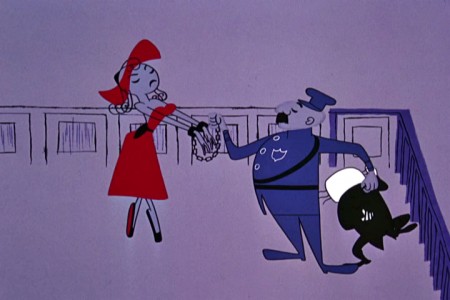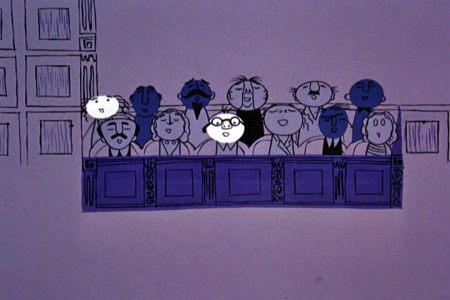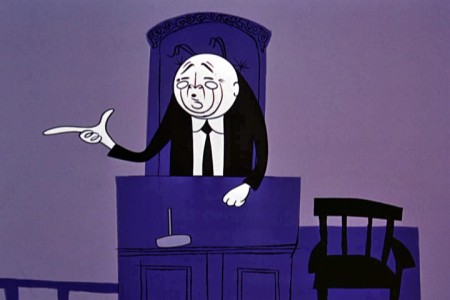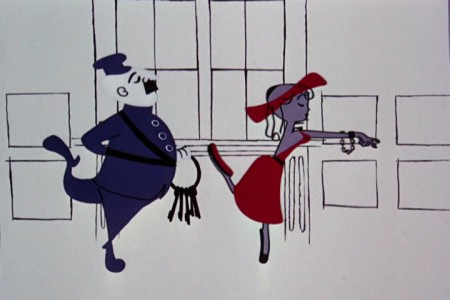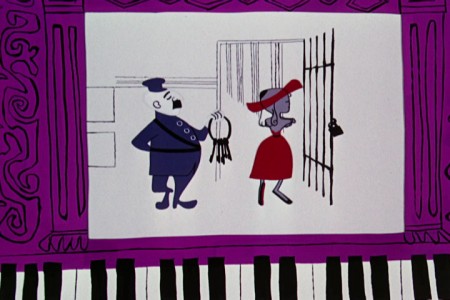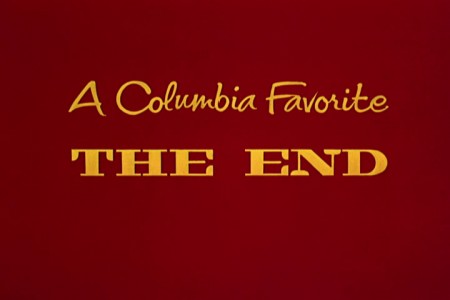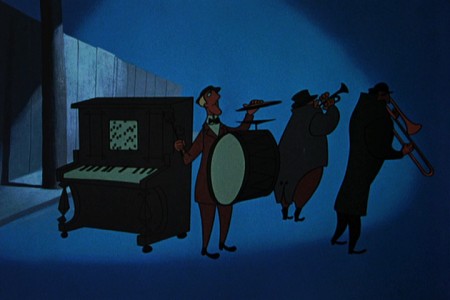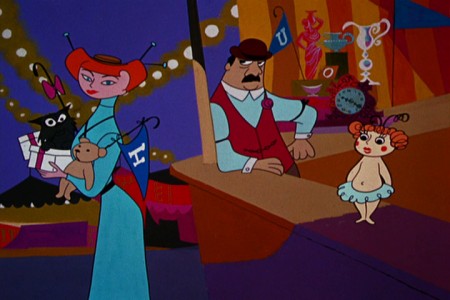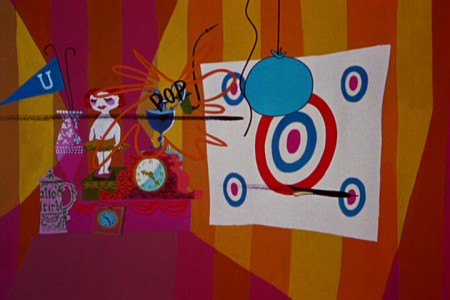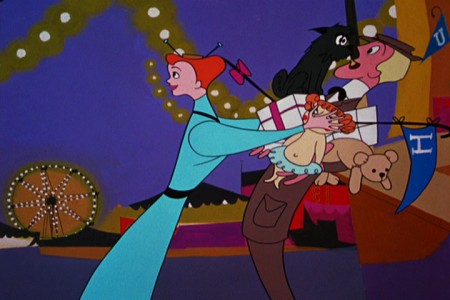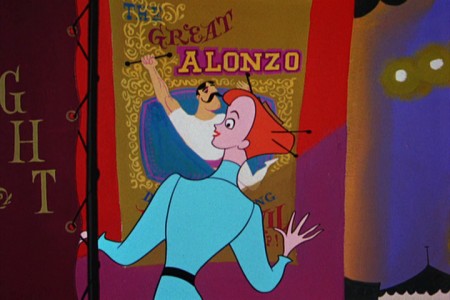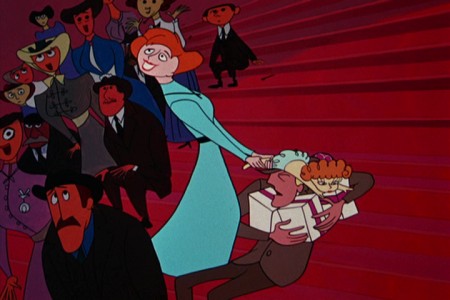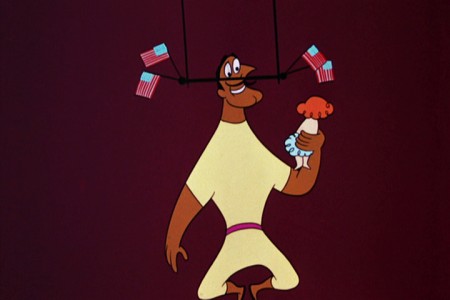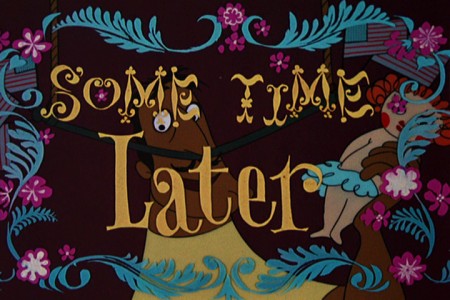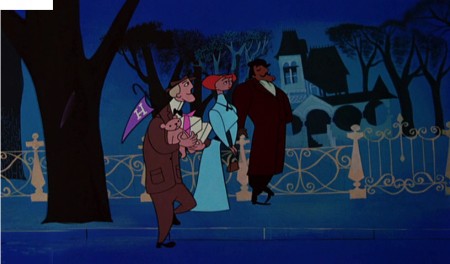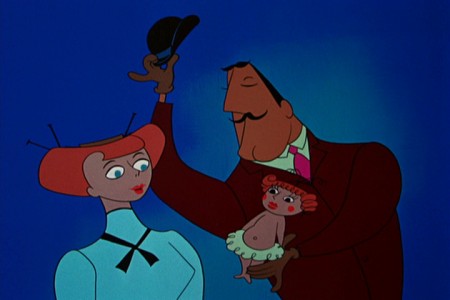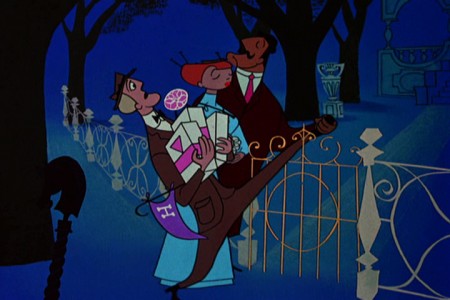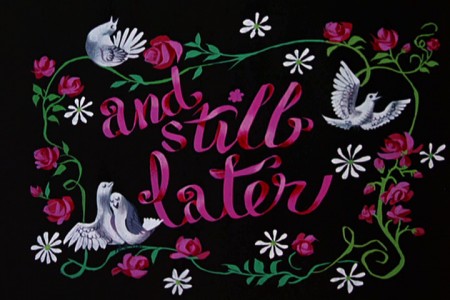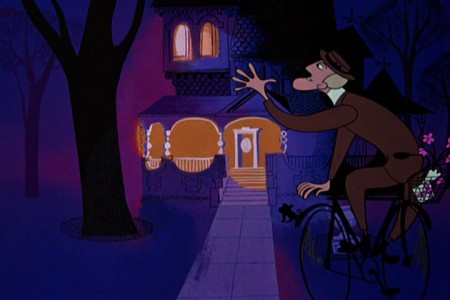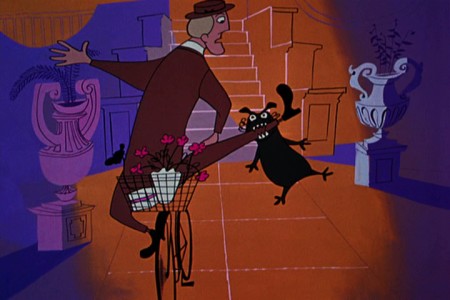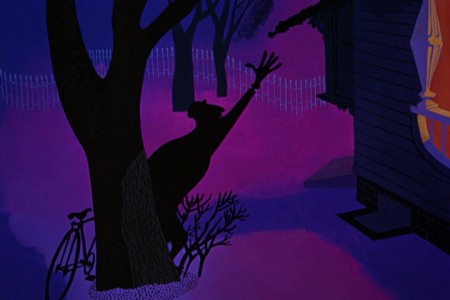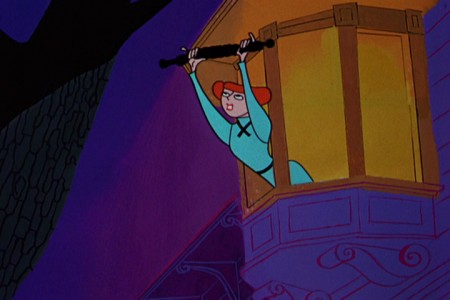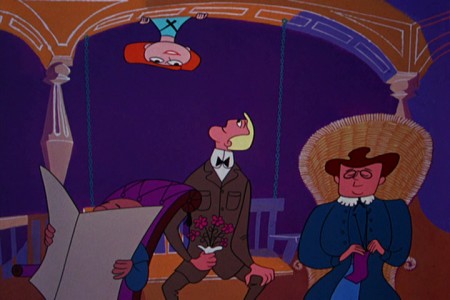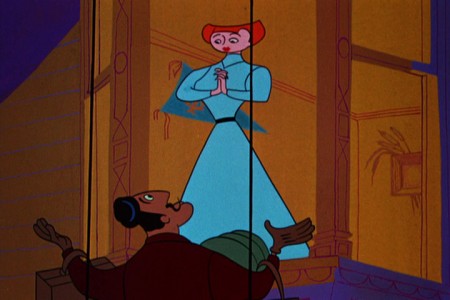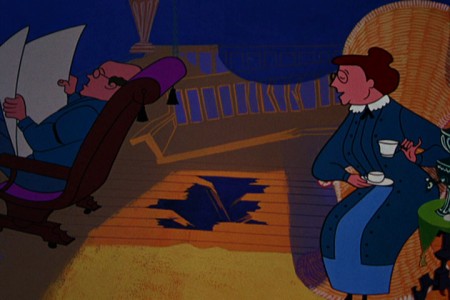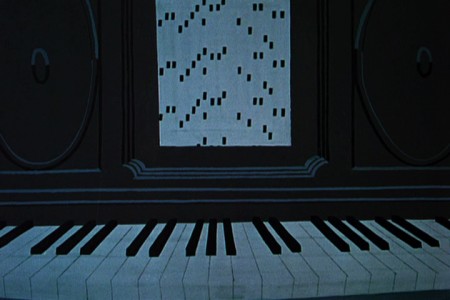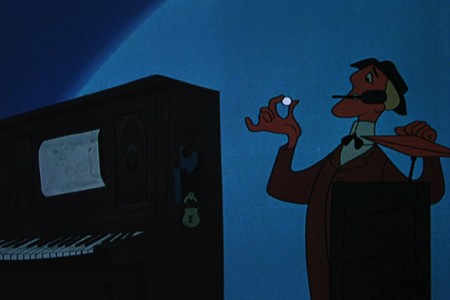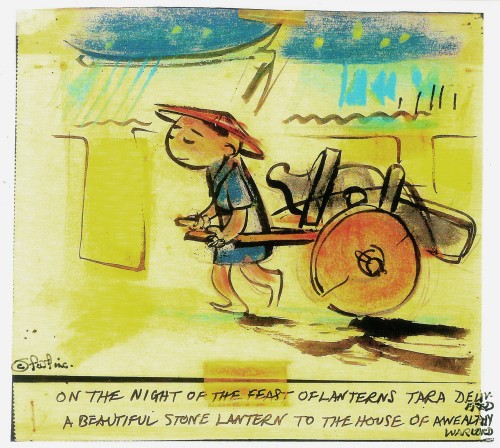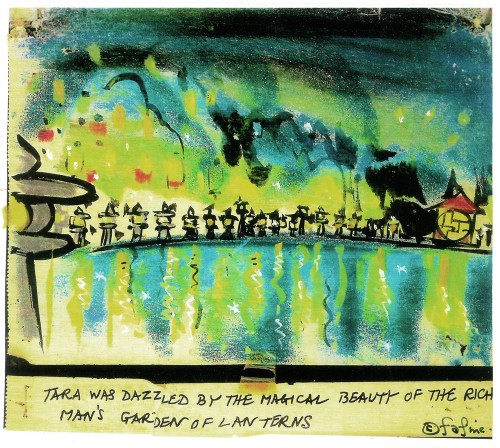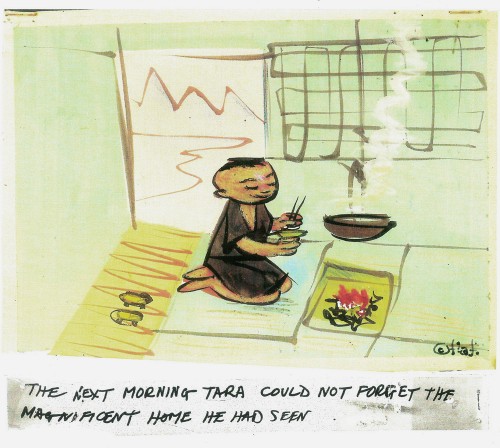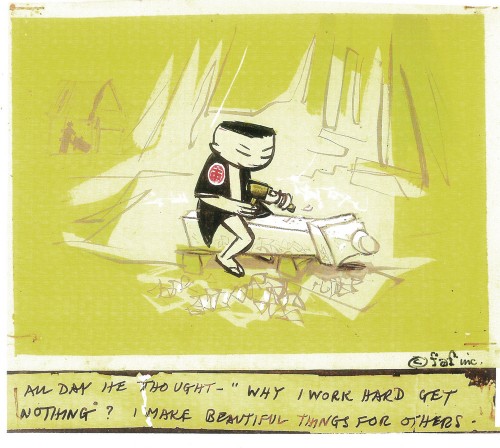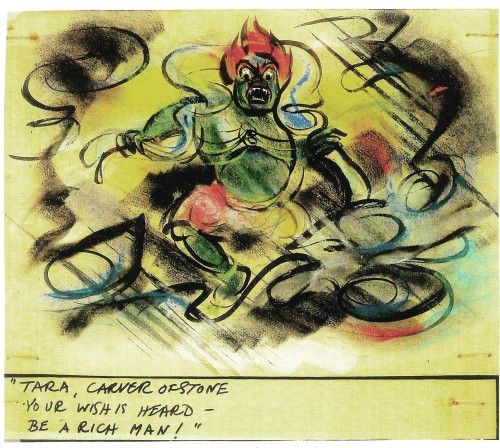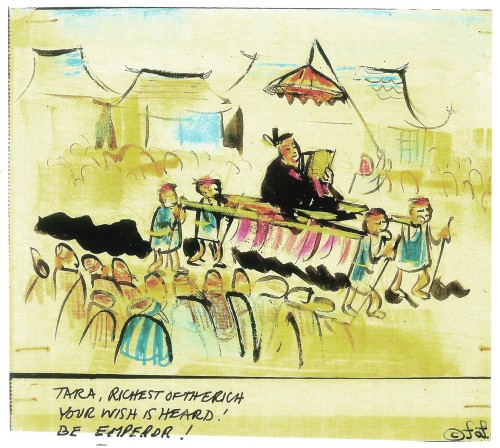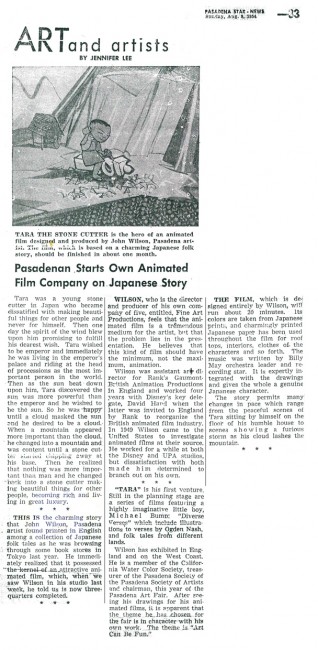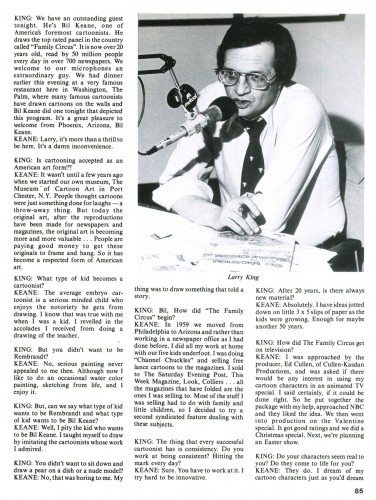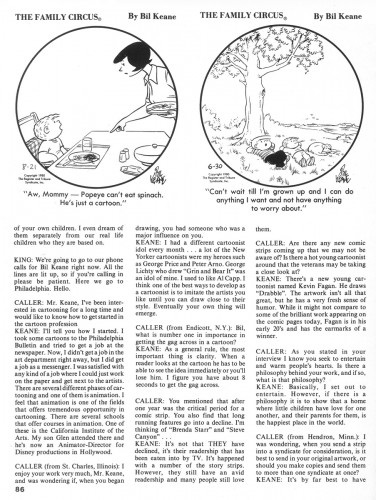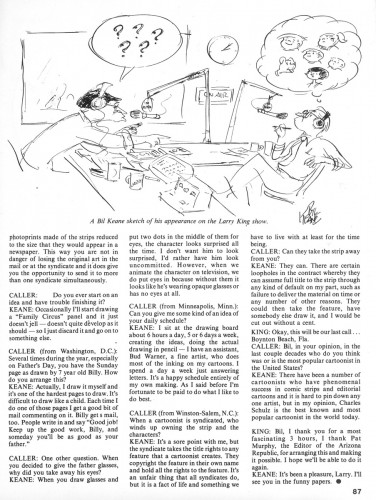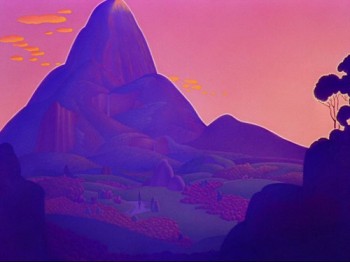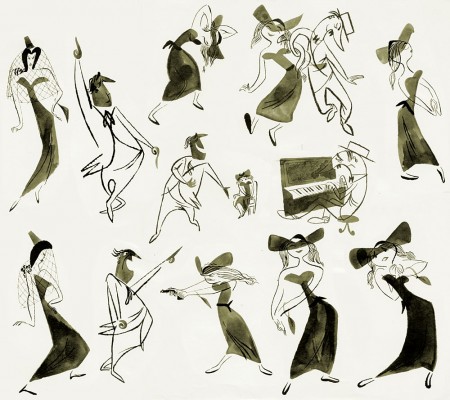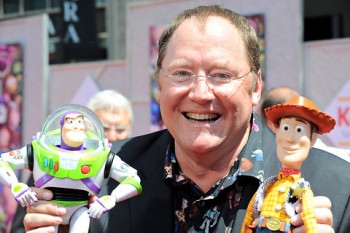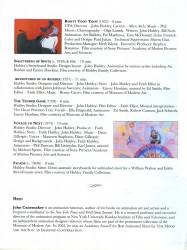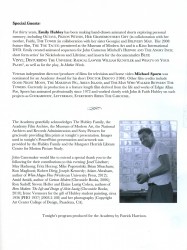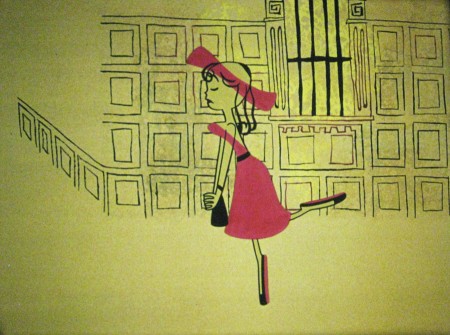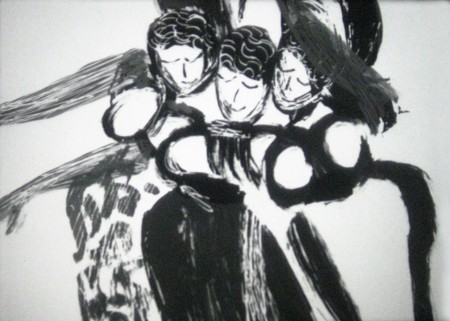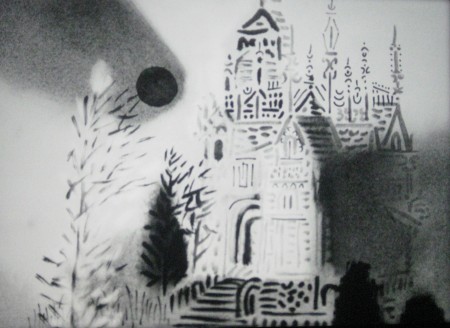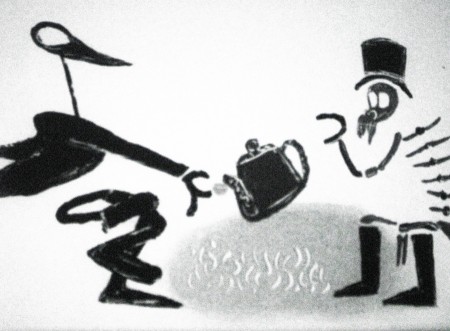Search ResultsFor "toot art"
Animation Artifacts &Frame Grabs &Hubley &UPA 28 May 2012 06:21 am
The Four Poster
- One of the real neglects in animation history is the availability of The Four Poster in VHS, DVD or any other format. For some reason, this title has eluded marketers who’d want to cash in on the name of Rex Harrison or his wife, Lilli Palmer. Where’s TCM when you need them.
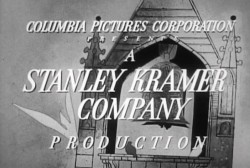 This film was a Stanley Kramer production directed by Irving Reis in 1952 of a play by Jan de Hartog. It tells the life story of a marriage between the husband and his wife. In fact, the film is so insular that it never leaves the bedroom, and it revolves around the “four poster” bed in that room. For the film, they chose to open it up by leaving the bedroom via animated inserts done by John Hubley at UPA. There are some 20 minutes of the film done by Hubley/UPA, and it’s extraordinarily progressive animation for the time.
This film was a Stanley Kramer production directed by Irving Reis in 1952 of a play by Jan de Hartog. It tells the life story of a marriage between the husband and his wife. In fact, the film is so insular that it never leaves the bedroom, and it revolves around the “four poster” bed in that room. For the film, they chose to open it up by leaving the bedroom via animated inserts done by John Hubley at UPA. There are some 20 minutes of the film done by Hubley/UPA, and it’s extraordinarily progressive animation for the time.
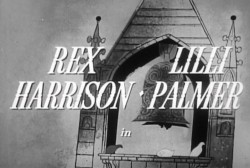 I own a good 16mm copy of the whole film, and cut the animation segments separate from the feature, I allowed a friend to make a video copy but was very disappointed with the results – out of focus and almost unwatchable. In the past couple of weeks, another friend led me to a second DVD copy which is also out of focus but not as bad as the first.
I own a good 16mm copy of the whole film, and cut the animation segments separate from the feature, I allowed a friend to make a video copy but was very disappointed with the results – out of focus and almost unwatchable. In the past couple of weeks, another friend led me to a second DVD copy which is also out of focus but not as bad as the first.
I’ve wanted to focus on this film for some time, hence I decided not to wait any longer and am sharing frame grabs with you of this muddy, soft focus version. You can still get the idea. If another, better copy turns up in the future, I’ll rework these images and repost it.
Here are bits from the opening credits. Lots of traveling right and then left and then right again.
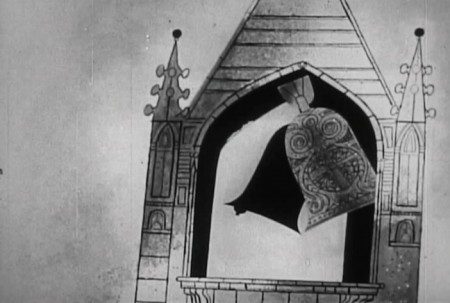 3
3The film does get very claustrophobic staying in the one bedroom set
for the entire film, with just the two characters, husband & wife, to talk
us through most of the movie. It’s exhausting.
This makes the animation more welcome than it would ordinarily be.
You’re dying for any excuse to change scenery and move the story forward.
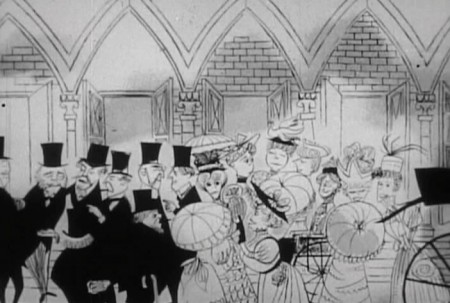 4
4
On top of this, the live action is very theatrical
whereas the animation is full of life and quite lyrical.
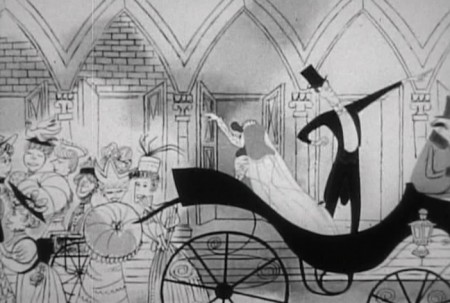 5
5
The animation does reveal a good part of the story from the
birth of their boy to his death in WWI on the front lines.
(Hubley designs one of his greatest sequences for this one.)
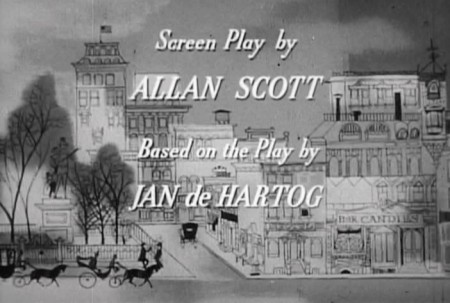 8
8
Supposedly, the film was sent to Yugoslavia for a run.
Some of the people in Zagreb were able to kidnap the film
and hold onto it for a number of additional weeks. They
studied it closely and copied it.
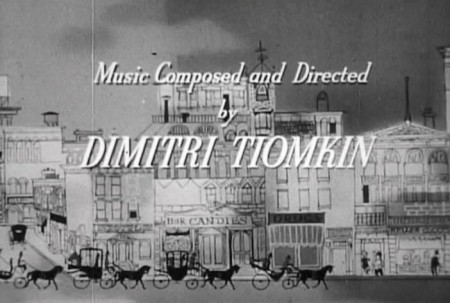 9
9
When they were finished the print was returned to
the States, and they started up Zagreb animation with their
new-found knowledge and inspiration. A bit more than inspired,
shall we say. How very 21st Century of them
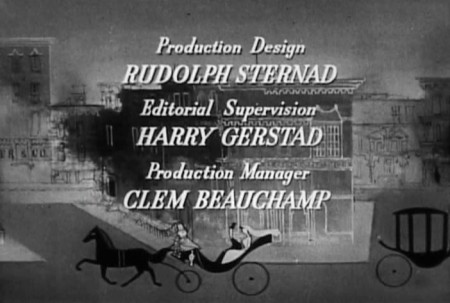 12
12
In his book, When Magoo Flew, Adam Abraham doesn’t give a lot of
space to the work on this feature. However, every small comment
seems valuable since so little has been written about this film.
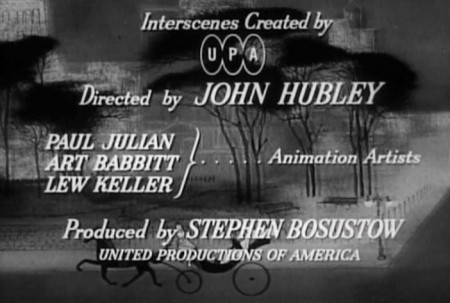 13
13
Abraham says that Hubley and crew went onto this directly after
finishing Rooty Toot Toot. They were broken into small groups
with each group doing one of the interecenes in the feature.
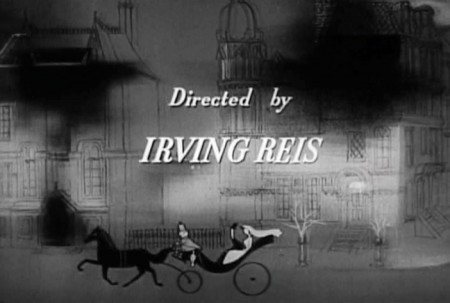 15
15
Paul Julian oversaw the stylistic representation of the War
and Art Babbitt animated the sequence showing the effect
of the war on the soldiers coming home.
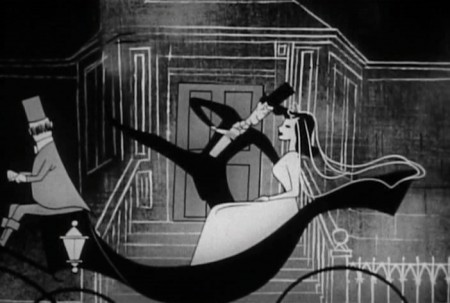 16
16
In total, it’s an enormous accomplishment.
____________________
.
The first animated intersection shows the Rex Harrison character going off to work as a teacher in a boys’ school.
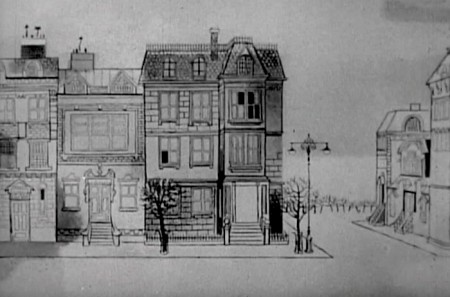 1
1
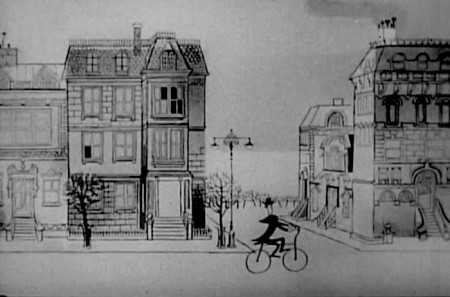 2
2
Out of the home, Rex Harrison’s character
comes cycling on his way . . .

. . . to school. Like many other sequences in this animation,
he rides a long pan to the school where he enters on bike.

Inside the school, we echo the first scene with another pan.
This time we pan from class to class ending with . . .
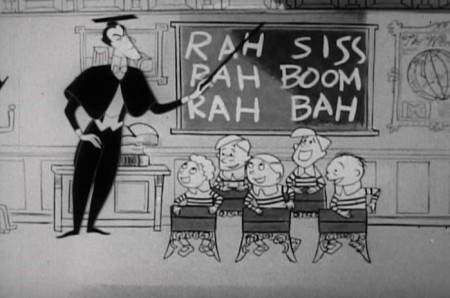 5
5
. . . Rex Harrison’s very unethical class, where the kids are having fun.
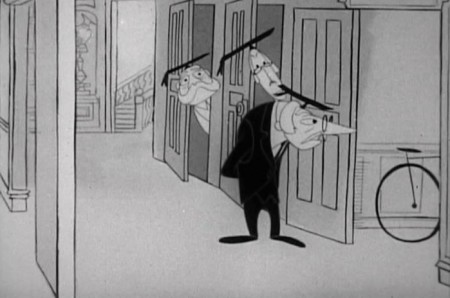 8
8
The raucus noise of his class is disturbing other teachers.
They don’t like the students having fun.
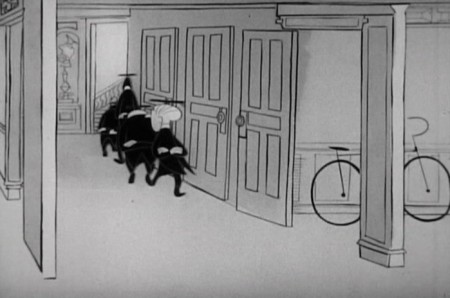 11
11
Off to the Dean’s office to complain.
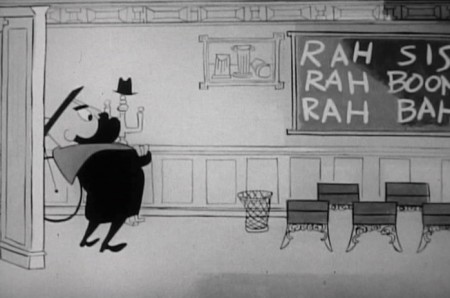 16
16
The Dean breaks in to something too much fun.
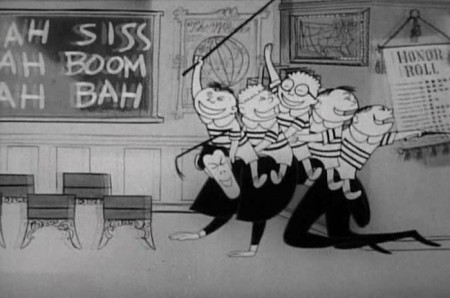 17
17
Even with the soft focus, you can see
that the character design is great.
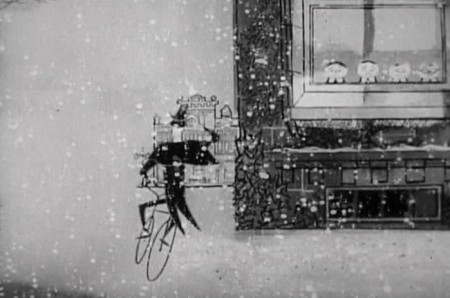 20
20
He goes off into the sunset of a
snow fall.
Back to live action
Animation &Animation Artifacts &Frame Grabs &UPA 22 May 2012 06:55 am
Nelly Bly’s Twisted Arms
This is one of my favorite scenes of all time. Nelly Bly is on the witness stand, and she’s constantly straightening herself out as she gets deeper and deeper into her side of the story. Grim Natwick’s animation is perfect, and John Hubley’s direction and design is even better. The judge, behind her, couldn’t be better positioned.
This is a great cartoon, possibly UPA’s best. It lost the Oscar to The Two Mousketeers, a Tom and Jerry cartoon, and not even a particularly good Tom and Jerry cartoon. It would take another ten years before AMPAS ruled that you had to see the short films to be able to vote on them.
I tried to include this scene with its soundtrack, but it took longer than I could afford to give it.
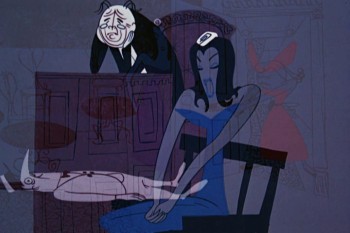 01
01
______________________
The bump in the middle is a hold wherein there’s a
camera move. I replaced it with a short dissolve.
Frame Grabs &Hubley &UPA 21 May 2012 05:15 am
Rooty Toot Toot
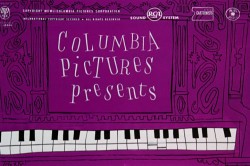 - As you know, I like this cartoon. Rooty Toot Toot. I think it’s one of the very best animated films ever made. The film combines brilliant design, with great animation, and an extraordinary story.
- As you know, I like this cartoon. Rooty Toot Toot. I think it’s one of the very best animated films ever made. The film combines brilliant design, with great animation, and an extraordinary story.
Kurosawa had directed Roshomon in 1950, and it had just touched down in the US. This tells of several people who meet up while waiting out a rain storm as they tell their differing versions of the killing of a samurai. It 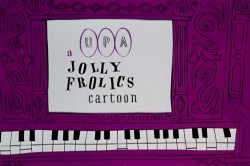 takes place in 12th Century Japan. There is no doubt that Hubley saw this film and does his cartoon adaptation of Frankie & Johnny using the same schema. It was not only daring for animation, but it was daring for film. It took the hands and eyes of a master to pull it off, and Hubley succeeded in the short 8 min cartoon.
takes place in 12th Century Japan. There is no doubt that Hubley saw this film and does his cartoon adaptation of Frankie & Johnny using the same schema. It was not only daring for animation, but it was daring for film. It took the hands and eyes of a master to pull it off, and Hubley succeeded in the short 8 min cartoon.
There is the legend that Steve Bosustow tried to get Hubley to speed up the
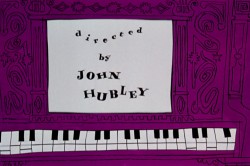 storyboard/writing process where finally the director had to lock himself and the board in to keep the production on hold until he thought it was finished. Eventually, according to the story, Bosustow broke down the door and put the film into its next phase. I don’t know what truth is in this, but I assume there must be a little something to it.
storyboard/writing process where finally the director had to lock himself and the board in to keep the production on hold until he thought it was finished. Eventually, according to the story, Bosustow broke down the door and put the film into its next phase. I don’t know what truth is in this, but I assume there must be a little something to it.
Unlike most other UPA films, this movie was made for an adult audience and it had no
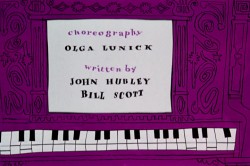 children to speak down to. Unlike most other UPA films, the art style came from 20th century art, not “illustration.” The inspiration was more Steinberg, Ben Shahn and WPA than Vanity Fair or the New Yorker.
children to speak down to. Unlike most other UPA films, the art style came from 20th century art, not “illustration.” The inspiration was more Steinberg, Ben Shahn and WPA than Vanity Fair or the New Yorker.
I’ve decided to pull frame grabs from the film, but that can only account for some still graphics. You really have to see this in motion, and I suggest you watch the version on the TCM Jolly Frolics DVD. It’s the only version that has a good transfer which does the design justice.
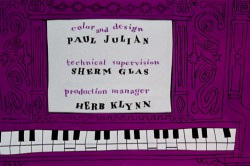
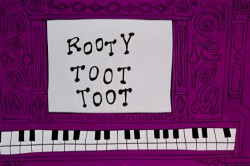
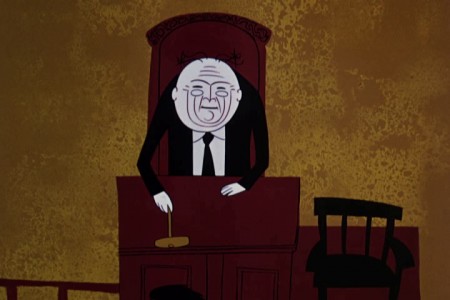 2
2
Gold colors dominate the opening of the trial,
except for Frankie’s bright red dress.

Frankie appears, to stand trial.
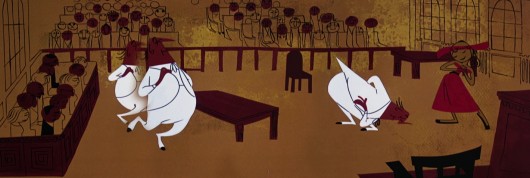
The defense does a dance with Frankie
as he caresses his client.
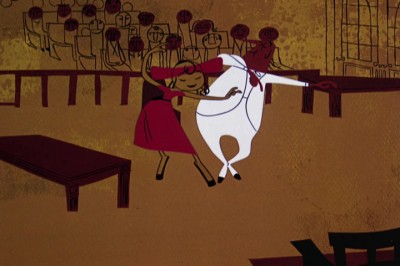 6
6
Choreographer Olga Lunick earned her money on this scene.
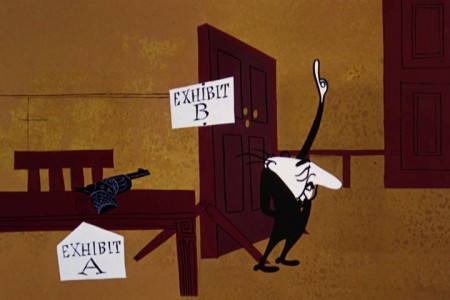 10
10
An open and shut kind of case.

The bartender is the first witness.
He waves hello to half those seated,
before raising his right hand to be sworn in.
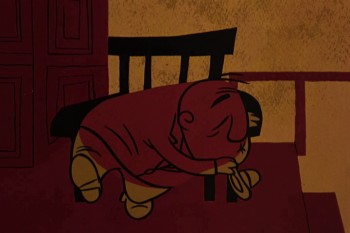 12
12
The bartender brings a subtle color change as
we move from gold hues to brownish colors.
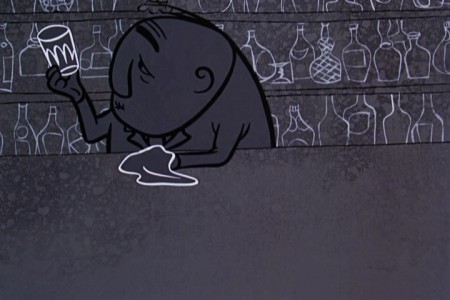 16
16
Once we go back to the bar, bluish grays take the scenes.
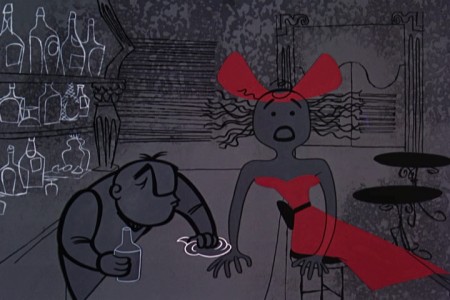 20
20
The bartender revealing Nellie Bly in the back room
foreshadows his reveal at the end of the film.
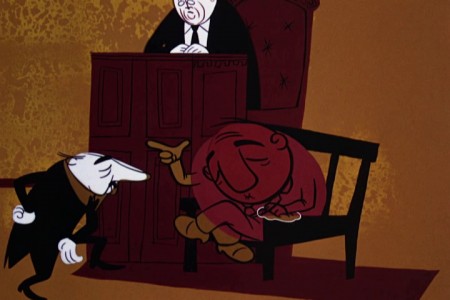 24
24
Back to the browns and ochres in the courtroom.
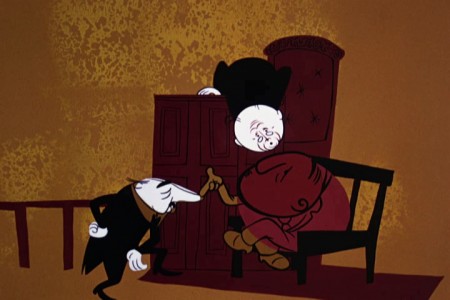 25
25
“Right in the snoot . . . ”
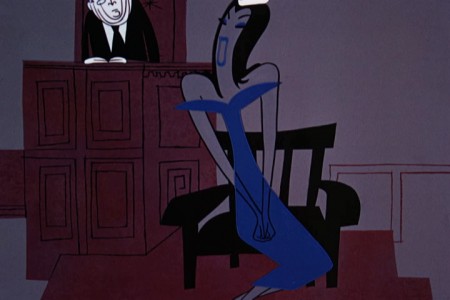 27
27
Nellie Bly brings her violets, lavenders and blues.
The exact opposite of Frankie’s colors.
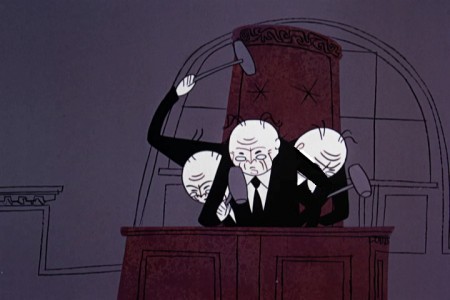 29
29
Order in the court.
The judge doesn’t smear; he breaks into multiple versions
of himself frenetically hammering his desk.
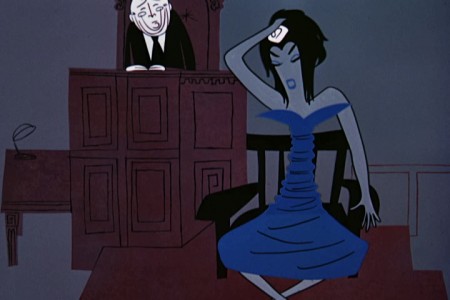 33
33
Straightening out the story . . .
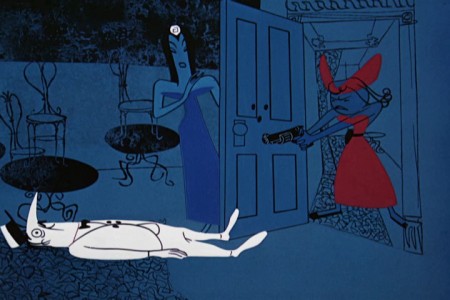 45
45
All blues except for that dress.
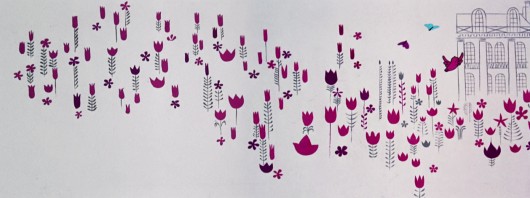
Frankie’s story comes in lily whites and white on white.
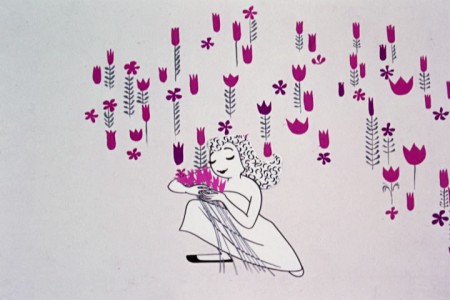 55
55
Her hair in this sequence was matted into the animation.
The decorative pattern didn’t move within the body of the hair.
A real pain in the butt for a design technique. Multiple camera runs.
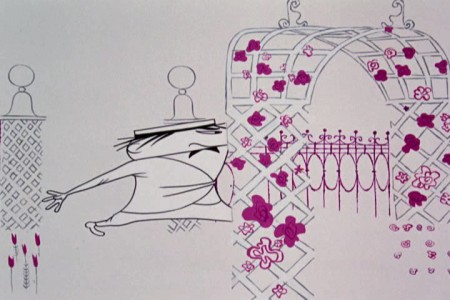 57
57
Smear frames are used in this sequnce for Johnny.
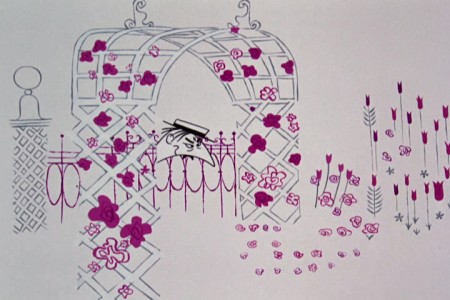 58
58
the victim is made to be the evil one.
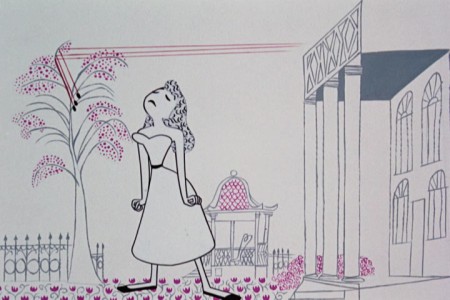 67
67
The bullets ricochet, musically, all over the place.
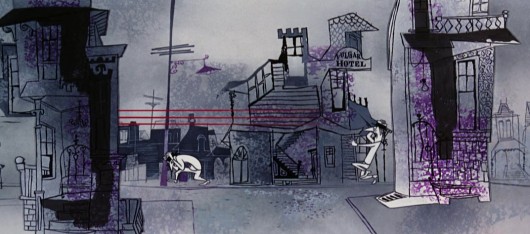
The pure whitish backgrounds turn to dirty grays.
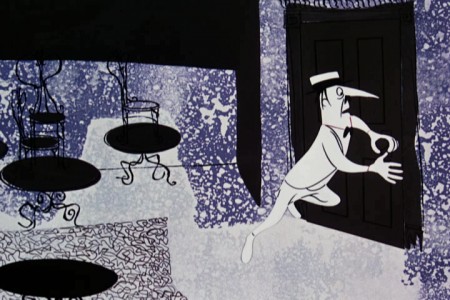 78
78
There’s a reuse of the gag as he looks out the door (see #40 on),
but the animation is different. No expense spared on this film.
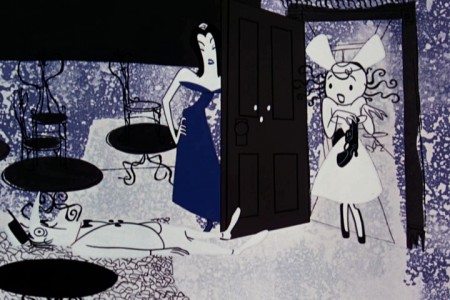 88
88
Back to the courtroom, vermillion is the color dominating.
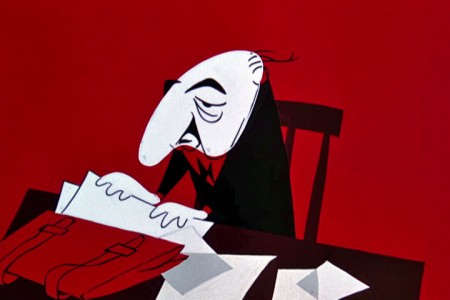 97
97
Back to the courtroom, vermillions turn to
deep reds as the innocent verdict is revealed.
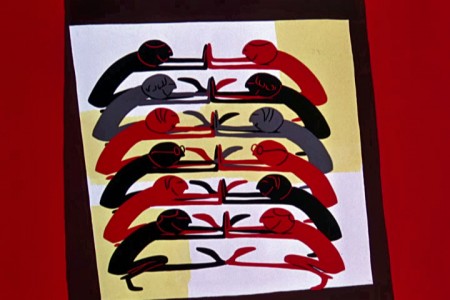 103
103
Very short quick scenes scream at the audience.
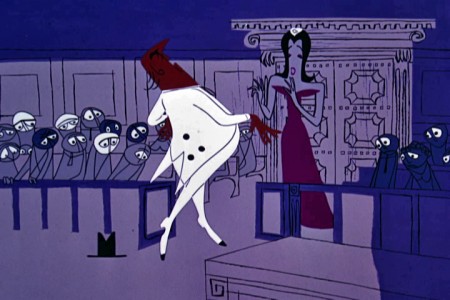 108
108
The attorney’s murder brings bright violets and lavenders.
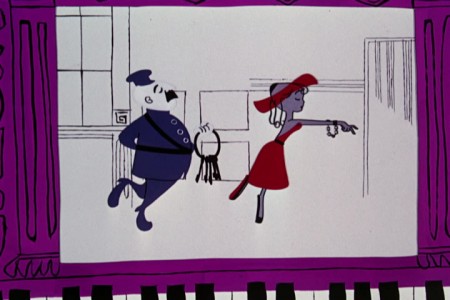 116
116
The lavenders dominate until we pull out
on the purple player piano.
This film, like Nordshtein’s Tale of Tales, is proof that animation can and should be as sophisticated as live action and as adult as any film. This is most certainly one of the classics in animation history. It’s only the animators and producers that hold the medium back.
commercial animation &Layout & Design &UPA 16 Apr 2012 04:59 am
The Man on the Flying Trapeze – pt.1
- The new UPA dvd 3-set comes in three separate categories: there are the Great films, the Good films, and the Bad films. Definitely, one of the Bad films is The Man on the Flying Trapeze. It seems to want to be either The Dover Boys or Rooty Toot Toot, and it’s most certainly neither. The film is just poorly plotted. There are some interesting transitions and some interesting set pieces. I give credit for that to the designer.
The designer is Paul Julian who also did the backgrounds, and his work, as far as I’m concerned, is brilliant. I decided to pull frame grabs of this film to highlight the beautiful design and background work of Julian. It’s taken a very long time, and I’ll have to break this post into two. I just can’t get it all done in one day. But I hope you can see the excellence of Julian’s work.
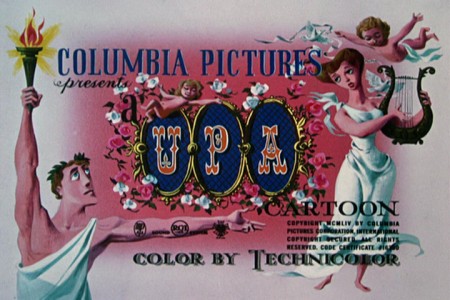 1
1Just a brlliant title card.
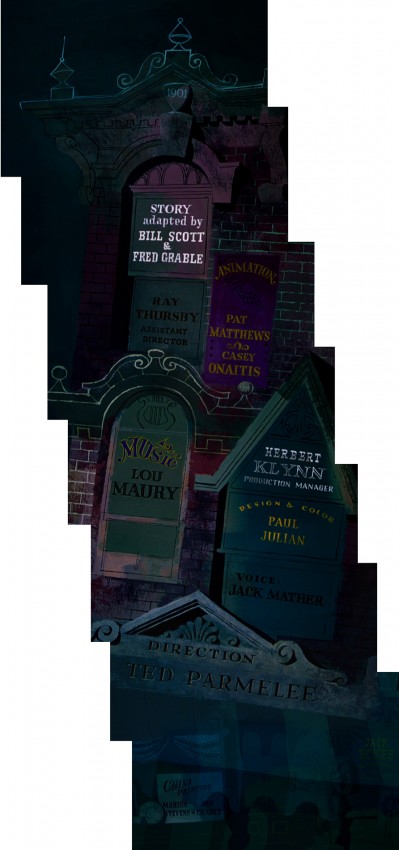 2
2
A slow pan down over the credits.

Left to right stoppng on the main title.
Then continuing into the scene.
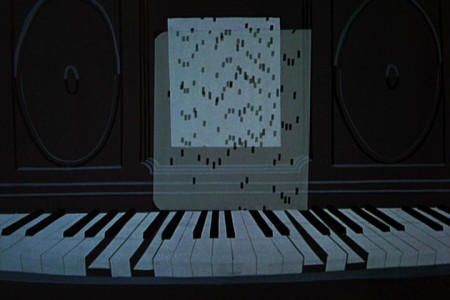 5
5
The player piano sets the mood for the entire film.
A ragtime score, piano leading, with little consequential dialogue.
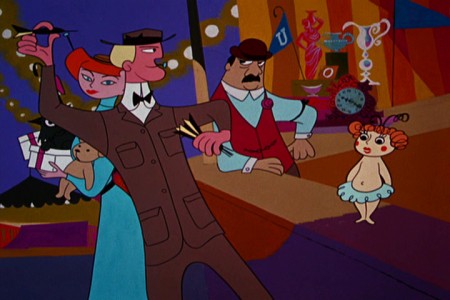 7
7
The guy just fades on, in place, ready to throw the dart.

Pan left to right with the Trapeze Artist.
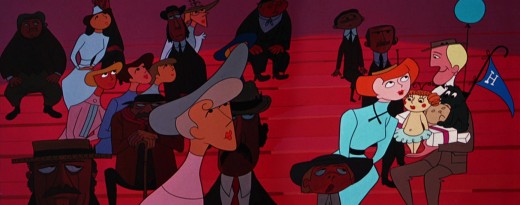
Slow pan left to right with the audience.
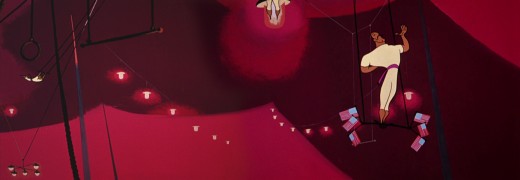
Again pan left to right with the Trapeze Artist.
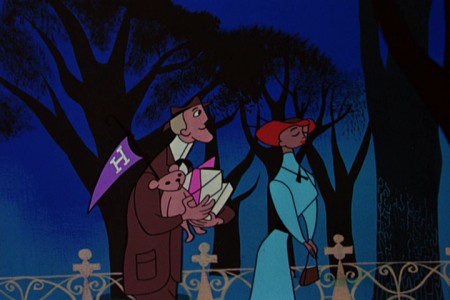 17
17
Beautiful trees remind me of the scene in The Dover Boys
where the villain pulls the heroine away from the tree.
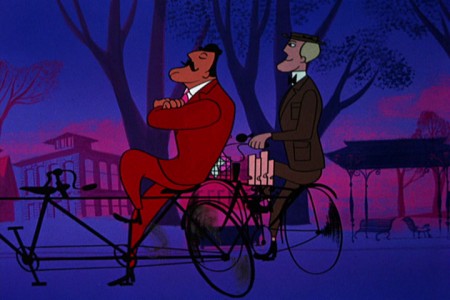 23
23
The man from the trapeze passes our hero . . .
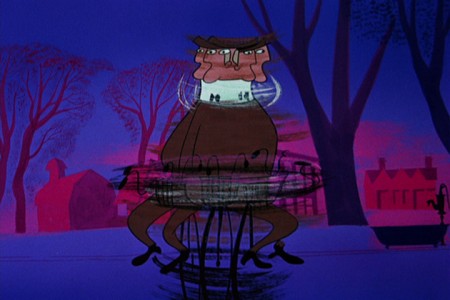 24
24
. . . who spins out of control.
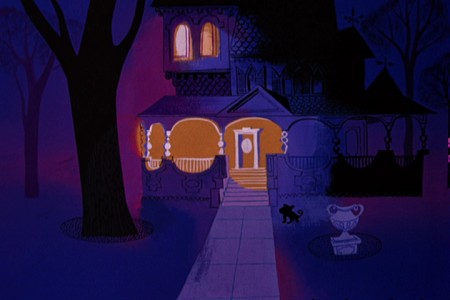 25
25
A beautiful Julian house and a great new color scheme
for this section of the film.
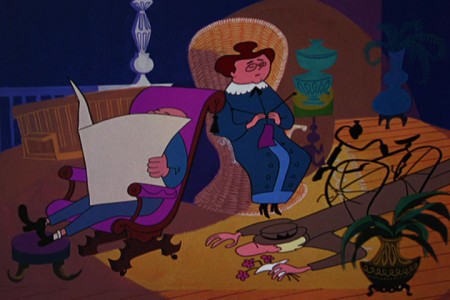 28
28
Taking advantage of the new colors to . . .
to be concluded next week.
Books &Hubley &UPA 07 Apr 2012 07:20 am
When Magoo Flew & Jolly Frolics
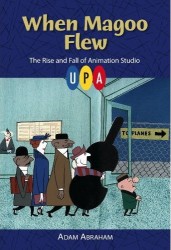 – Adam Abraham‘s new book, When Magoo Flew: the Rise and Fall of Animation Studio UPA, is a gem. It’s an intensely researched and informed book about a studio that has gotten little real attention before this. There have been bits and pieces about specific films and people at the studio, and there’s the extraordinary chapter in Mike Barrier’s Hollywood Cartoons which encapsulates much of the material in this book.
– Adam Abraham‘s new book, When Magoo Flew: the Rise and Fall of Animation Studio UPA, is a gem. It’s an intensely researched and informed book about a studio that has gotten little real attention before this. There have been bits and pieces about specific films and people at the studio, and there’s the extraordinary chapter in Mike Barrier’s Hollywood Cartoons which encapsulates much of the material in this book.
When Magoo Flew starts off in a political mode, and in some way it stays there throughout. Perhaps that’s at the heart of the UPA story. At first, we read about the Disney strike which caused many artists and renegades to leave the Disney studio and strike out for something bigger, freedom to draw in a more modern mode. The book stays with politics as we see the formation of the UPA studio; there’s so much in fighting as partners turn on each other to take control of the studio. Once they’re in the heyday of the studio it’s the politics of who’s doing what. Animosities played a large part. When John Hubley didn’t like the painting of Herb Klynn, (“I cannot stand another touch of that Klynn green!”) he brings the brilliant painter, Paul Julian, into the studio. When Jack Heiter refused to listen to Jules Engel‘s demand to change to color ofthe sky in a background, Heiter was fired. Eventually we move to the politics of the HUAC hearings and the McCarthy era anti-Communist attacks on Hollywood. Finally, it gets down to the politics of selling and reselling the studio and the archives.
It’s a compelling story.
Within this book of politics, we see every film develop and succeed or fail. From Hell Bent for Election to Ragtime Bear (and Mr. Magoo) to Gerald McBoing Boing to Rooty Toot Toot. We see the careers of John Hubley, Bobe Cannon, Pete Burness, and many others develop and grow. All the info is in there: the history of the key shorts as well as the many feature attempts amd the two completed, as well as the mini-bios of all the people. It’s one of those books where you trust the facts and are sure the author did the homework. (The only quibble I had was in his saying that Hubley had one “big” shot at a feature with Watership Down, when in fact Hubley produced and directed two features of his own within his studio, although maybe Abraham didn’t mention them because they weren’t “big”.)
This is what I consider to be an important book in my collection, and I’d encourage everyone interested in animation history to get a copy if they can. At least, get yourself to a library to read it. I’d also like to suggest that you check out Mike Barrier‘s comments about the films of UPA in his review of the DVD. He links to the chapter in his book about the history of the films.
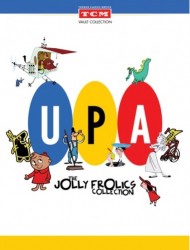 There’s also a companion piece – a DVD that was released by Turner Classic Movies, and it, too, is a treasure. Jolly Frolics, the UPA Collection contains beautifully reconstructed copies of many of the one-off films, the Jolly Frolics. These, for the most part, were the non-Magoo shorts. (There will be an all Magoo release this coming June.) Many were directed by Bobe Cannon, but there are plenty of othrs by Hubley, Babbitt, and Burness as well. (I ceertainly plan to use this DVD to really go into the films and comment on some of them in the future. There’s too much wealth here for me to pass by.)
There’s also a companion piece – a DVD that was released by Turner Classic Movies, and it, too, is a treasure. Jolly Frolics, the UPA Collection contains beautifully reconstructed copies of many of the one-off films, the Jolly Frolics. These, for the most part, were the non-Magoo shorts. (There will be an all Magoo release this coming June.) Many were directed by Bobe Cannon, but there are plenty of othrs by Hubley, Babbitt, and Burness as well. (I ceertainly plan to use this DVD to really go into the films and comment on some of them in the future. There’s too much wealth here for me to pass by.)
The brilliance of Rooty Toot Toot or Gerald McBoing Boing or The Tell Tale Heart stands out against many of the others which here seem even more ordinary. The Man on the Flying Trapeze or Baby Boogie or Giddyap prove that not all UPA films are gems. Like any other cartoon studio’s product, there were good, bad and, mostly, mediocre films.
However, this collection are all marvelously brought back to their original life with this release, and TCM has to be applauded for this first collection of cartoons among their releases. The extras on the DVD includes commentary tracks by Jerry Beck and Leonard Maltin. These are worthless, as far as I’m concerned. Half of their comments involve complimenting the newly found colors of the DVD copies. Neither seems to know more than the basics about UPA. After the first commentary track, they’re all the same. With this DVD, you’re buying them for the fantastic originals on display.
When I was 11 The Gerald McBoing Boing Show premiered on CBS. Anything to do with animation meant it was playing on my family’s TV set. Ohere than these cartoons, everything anmated on TV meant the old B&W WB cartoons featuring the fat Porky Pig. There were early B&W Terrytoons as well, and even some Aesop’s Follies (silent cartoons with classical music tracks added) running on ABS. Of course, there were the special Disneyland TV shows which ran not often enough for my taste.) But the UPA cartoons were different. They looked different, they moved differently, and they struck my young eyes as important. I became an instant fan. I’ve waited for this book and DVD most of my life. It was worth the wait.
Animation Artifacts &commercial animation &Independent Animation 09 Jan 2012 06:18 am
John Wilson/Fine Art Films – part 1
- For the next three weeks, I’m going to focus on director/designer/animator, John Wilson.
Amid Amidi presented me with some art that he thought might be a good match for this blog, and it is. So I’ll take advantage of the material and share it with you. With each week’s post I’ll hone in on one specific film and go from there. We’ll start with Wilson’s first solo film, Tara the Stone Cutter completed in 1955.
But first, let me share some bio information about John Wilson and his company Fine Arts Films.
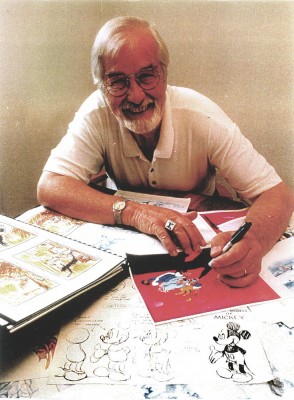 - John Wilson was born in Wimbledon in 1920. He attended the Royal College of Art and was working by age 18 as a commercial artist with Willings Press Service. In WWII he served with the London Rifle Brigade in African where he was seriously wounded. Recuperating in hospital, he drew many cartoons of which several were printed. Eventually he would recover and get work at Pinewood Studios in the art department where he worked on GREAT EXPECTATIONS and THE THIEF OF BAGHDAD, among other films.
- John Wilson was born in Wimbledon in 1920. He attended the Royal College of Art and was working by age 18 as a commercial artist with Willings Press Service. In WWII he served with the London Rifle Brigade in African where he was seriously wounded. Recuperating in hospital, he drew many cartoons of which several were printed. Eventually he would recover and get work at Pinewood Studios in the art department where he worked on GREAT EXPECTATIONS and THE THIEF OF BAGHDAD, among other films.- By the time he was 25, he was working in animation at Gaumont-British Animation, a newly formed division of J. Arthur Rank’s studio, working under the direction of David Hand on the “Animaland” series starring “Ginger Nut.”
- In 1950 he moved to the United States working in layout and animation at UPA. He found himself working with Bobe Cannon, Pete Burness, Jules Engel, and Paul Julian. Eventually he left for the Disney studio working in Les Clark’s ‘Tinkerbell’ unit on PETER PAN and with Ward Kimball on TOOT WHISTLE PLUNK & BOOM.
- He tried to sell Disney on the film Tara, the Stonecutter, but they weren’t interested. He completed it himself in 1955 using a Japanese style to tell the story. Wilson was impressed with the UPA style of modern art in animation, and that’s the route he took for his personal film. Thus his studio was born, called Fine Arts Films, in 1955. Tara had some success playing theatrically with the successful Japanese feature film, GATE OF HELL by Kinugasa (which had won the Oscar for Best Foreign Film.)
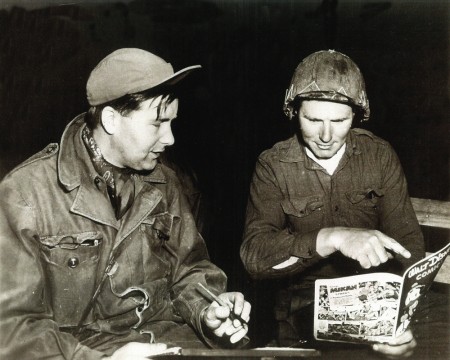
Wilson in Korea with the Bob Hope Tour to entertain the troops.
- This film led to his producing a verion of Stravinsky’s Petroushka for NBC which aired in 1956 as part of The Sol Hurok Music Hour. Notably, Stravinsky, himself, arranged and conducted the shortened version of the score suing the LA Philharmonic Orchestra. The film was designed by John Wilson and Dean Spille with anmation by Bill Littlejohn, Art Davis, and Phil Monroe. Chris Jenkyns, Dean Spille and Ed DeMattia designed the 16 minute show from Wilson’s storyboard.
- Fine Arts Films had produced ‘Journey to the Stars’, a project for the 1961 World’s Fair, an animated voyage through space for NASA, which was seen in 70 mm Cinerama by ten million visitors to Seattle.
- Billy Wilder employed Wilson to do the titles for Irma La Douce after which they did a six-minute trailer for this Jack Lemmon, Shirley McLaine feature. It was all about Parisian prostitutes romping about in Montmartre, and animation could apparently make it acceptable. Artists Ron Maidenberg, Sam Weiss, Sam Cornell and Bob Curtis caught the vivid nightlife of Paris in a sexually charged animated short. It was a huge success in promoting the feature.
- In 1970 Wilson flew to Chicago to see Carol Channing and Eddie Bracken appearing in “archy and mehitabel in Shinbone Alleyâ€. On the basis of this theatrical musical, Wilson bought the screen rights to the book “archy and mehitabel” by George Herriman and began work on an animated feature which was released by Allied Artists in 1971.
- Fine Arts Films was also responsible for many animated commercials as well as weekly music video segments for the weekly CBS-TV series “The Sonny and Cher Show.†The songs included Joni Mitchell’s “Big Yellow Taxi†and Jim Croce’s “Leroy Brown.â€
Here are some storyboard sketches by John Wilson for his initial short film, Tara, the Stonecutter. This film started it all for Wilson.
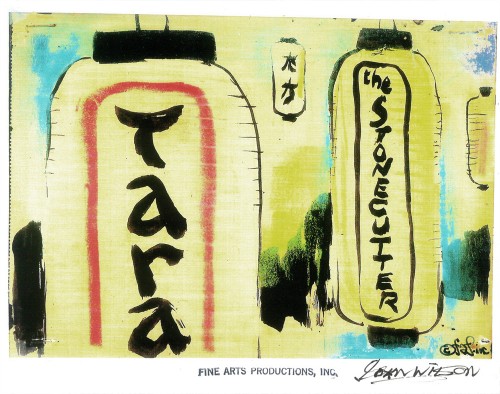 1
1
I haven’t seen the finished film, but I understand that Japanese decorative papers were used in the backgrounds and costumes of the characters.
Here are two press clippings for this film from California papers.
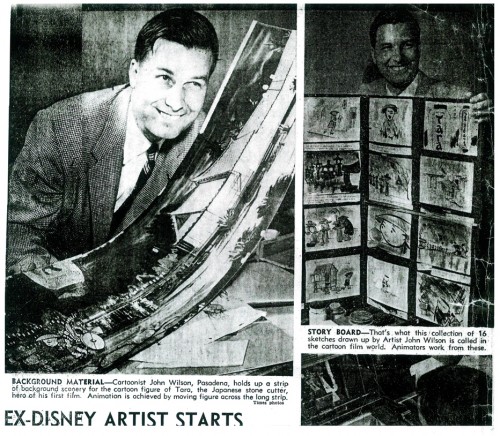
(Click any image to enlarge.)
Comic Art &Commentary 12 Nov 2011 07:44 am
Academy, Keane and Odds & Ends
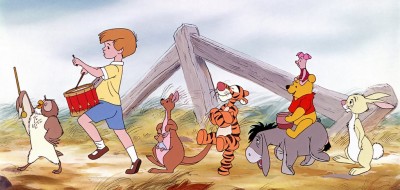
Academy voting time
- This past week was a relatively quiet one. I’ve been spending more and more of my time going to screenings for the Academy. Not only are there normal screenings at the AMPAS NY center (usually, at this time of the year, on Tuesdays and Thursdays), but there are also invited screenings. The Academy screenings have started to increase in that there are two films a night, and it gets to feel a bit like overload. I try to spread it out somewhat so that I avoid two films in one night by going to see some of the films at the invited screenings. Often present at these screenings are some of the celebrities from the films.
On Tuesday I saw the Lars Van Triers film, Melancholia – which droned on for four hours (or maybe it was just really 2’15″), and Thursday there was J. Edgar, the Clint Eastwood film with Leonardo DiCaprio. (2 hours 17 mins.) Definitely acting Oscar nominations in both films; both films had problems.
Starting next week the Animated Features begin screening. I have the DVD for Winnie the Pooh, but I’ve been trying to hold off seeing it until it’s on a big screen. As a matter of fact, that’s what I try to do with all the films, no matter how small. I try to see them all properly projected to be able to vote for them fairly. As for the feature animation, this is the first year the NY members are able to vote for the nominees in this category, so it’s something I’ll take seriously. That means I’ll have to sit through Hoodwinked 2 and The Smurfs in a theatrical setting (god help me). I do look forward to Winnie the Pooh, as I’ve said, as well as Cat In Paris on the big screen. (What can I say; I’m a 2D kinda guy.) After the theatrical screening, I’ll probably look at the DVD of W the Pooh a bit more closely.
Nest week, Between Sunday and Wednesday, there’s My Week with Marilyn, The Descendants as well as Rampart. There’s Puss In Boots and Tin Tin. To top it off, on Monday there’s a special screening dedicated to the work of Saul Bass – not Oscar related. It all starts to add up. But I’m not complaining; I actually love it and feel privileged to be able to take part in the process.
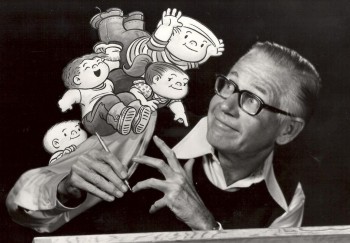 - I was saddened to learn of the death of Bill Keane, the cartoonist who created Family Circus in 1960. He was also the father of Disney animation director, Glen Keane.
- I was saddened to learn of the death of Bill Keane, the cartoonist who created Family Circus in 1960. He was also the father of Disney animation director, Glen Keane.
I was not the biggest fan of this comic strip when I was young. However, there was the Family Circus Christmas that aired one year. I thought it had one of the best stories ever done for a Christmas Special, and it gave me a new outlook on the strip. That show was directed by Al Kouzel in 1979 (Glen was one of the animators on the show). The animation isn’t very good, but the show reached out to me back then.
As a tiny tribute to Bill Keane, I’m posting this four page piece from Cartoonist Profiles, Dec. 1980 issue. It’s an edited transcript of an interview done with Bill on the Larry King Show.
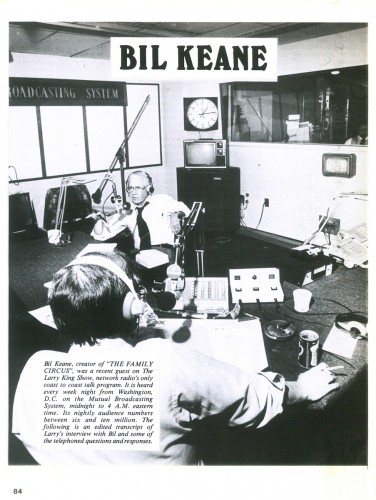 1
1Click any image to enlarge.
_____________________________
- I received this note a few days ago:
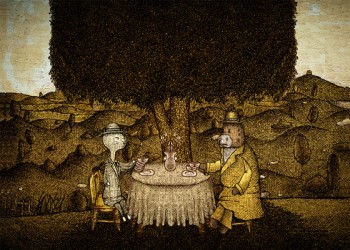 My name is John Kassab, and I was the sound designer on the Oscar winning short animated film, ‘The Lost Thing‘.
My name is John Kassab, and I was the sound designer on the Oscar winning short animated film, ‘The Lost Thing‘.
I am currently producing a wonderful animated short called ‘Cabbit‘ by emerging artist Soogie.
We are in the process of raising awareness about our Kickstarter fundraiser and wondering if you would like to check it out: here.
This is a little interview i did this week about the sound design: here.
… but we would love to get more attention for Soogie, our illustrator / writer / director / animator.
I don’t like to post Kickstarter events on this blog, so please don’t tell me about yours up and coming. There are too many films trying to raise money for me to be promoting any of them. I have my own films wanting funds and rarely mention them here. This film seems to want the funds primarily for post production.
- Bill Benzon has been writing in depth about Fantasia. On his blog, New Savannah, he’s been detailing the artistic and intellectual struggles visible in the film. Finally, he’s reached the last of the segments, the Pastoral, and he’s uncovered the sexuality just below the film’s surface. Bill writes:
- I saw the sexual undertones way back when. But it wasn¹t until I started taking frame grabs‹the last thing before I actually start writing‹that I noticed that all the thunderbolts are directed at Bacchus. And once I saw that, well, the fact that the last one exploded the vat full of grape juice . . . well, you¹ll have to read the post to see what I make of that.
He also posts that he’s going to put all of the eight segments together as a PDF. When he does that, I’ll let you know.
- Stephen Worth has started the Animation Resources blog. It’s a new place to check daily on your blog rounds. This is a way for Stephen to rekindle all the great posts from the old ASIFA Hollywood Animation Archive blog and for him to add some great new material. There was just too much good material there to let it pass on. You’ll notice it’s part of my blogroll to the right.
Commentary 15 Oct 2011 06:44 am
Ramble, Ramble, Ramble
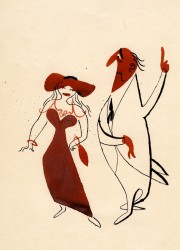 - This past week was a busy week for animation in New York.
- This past week was a busy week for animation in New York.
It started on Monday with the AMPAS celebration of John Hubley‘s early work. It turned into quite an event with beautiful prints of many of the early UPA films which began with the military film, Flat Hatting and led to the brilliant masterwork, Rooty Toot Toot. Some commercials and a few of the early, brilliant films of the Faith & John collaboration, Adventures of an * and Tender Game. It was a sterling evening well attended by many of the key personae in New York’s animation scene.
On the following night, ASIFA East held a retrospective of the work of the late and great Independent animator, Karen Aqua. I was unable to attend this screening but was certainly down about it. Fortunately, there were two key reports describing the show: Linda Beck, the new President 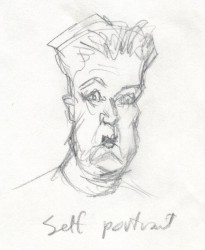 of ASIFA East, described the event on the organization’s blog, and Richard O’Connor of Ace and Son gave a good accounting on his blog.
of ASIFA East, described the event on the organization’s blog, and Richard O’Connor of Ace and Son gave a good accounting on his blog.
- Last night, Bill Plympton hosted a show at the Friar’s Club which featured the NY premiere of the new documentary by Alexia Anastasio, “Adventures in Plymptoons”, about him and his work.
Tonight at 7pm, at the Film Society of Lincoln Center Bill will doing a book signing of his “. . . big Rizzoli book, “Independently Animated: Bill Plympton”‘ He’ll be showing artwork from it and signing books and he’ll also be showing some of his new short films, plus a clip from Alexia Anastasio’s doc “Adventures in Plymptoons!”. All for free.
.BROOKLYN FILM FESTIVAL‘S kidsfilmfest will be screening films from their archives
WHEN: this Saturday, October 15th, from 10am-4pm.
WHERE: The Big Screen Plaza: 29th St between 6th and 7th Avenues in New York
WHO?: Kids of all ages!
WHAT: A selection of kid-friendly films, with in-plaza activities like face painting, balloon artists, popcorn, & more!
Join them for live action and animated films, food, face painters and more! Films are rated “G” for all ages.
The event is free of charge and open to the public.
_________________
 It should also be noted that the films of J.J. Sedelmaier will premiere at Big Screen Plaza on Tuesday, Oct 18th, 7pm. It’s free, outdoors and the atmosphere will be party time.
It should also be noted that the films of J.J. Sedelmaier will premiere at Big Screen Plaza on Tuesday, Oct 18th, 7pm. It’s free, outdoors and the atmosphere will be party time.
Some of the works to be screened include:
__ Saturday Night Live’s “Conspiracy Theory Rockâ€
__ Saturday Night Live’s “Titeyâ€
__ The Daily Show’s “Midterm Electionsâ€
__ Ambiguously Gay Duo: “Safety Tipsâ€
__ Ambiguously Gay Duo: “Ace and Gary’s Fan Clubâ€
__ Ambiguously Gay Duo: “Blow Hot, Blow”
and many others
.
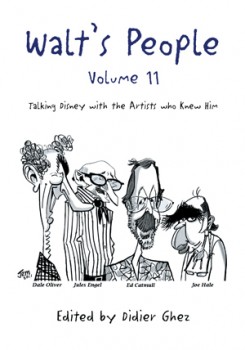
- Didier Ghez has been editing a library’s worth of books featuring interviews with animation professionals. For the most part these are the raw materials historians have worked with in writing their histories. Just now in release is volume 11 of his series, Walt’s People. There are interviews included in this edition with:
John Culhane: I. Klein_________________C. Finch & L. Rosenkrantz: Eric Larson
John Culhane: John Hubley____________Robin Allan: Jules Engel
Darrell Van Citters: Ed Love____________Darrell Van Citters: Mike Lah
JB Kaufman: Frank Thomas____________John Culhane: John Hench
John Canemaker: Ward Kimball________Dave Smith: Ward Kimball
David Tietyen: George Bruns___________John Canemaker: Dale Oliver
John Canemaker: Iwao Takamoto______John Canemaker: Richard Williams
John Culhane: Daniel MacManus________John Canemaker: Glen Keane
Didier Ghez: Joe Hale__________________Jérémie Noyer: Mark Henn
Didier Ghez: Ed Catmull
_________and many others.
The introduction to this edition is by John Canemaker.
You’ll find the book Walt’s People – Vol. 11 at Amazon or Xlibris
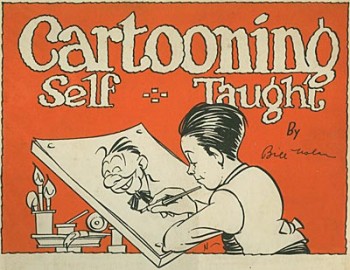
- Sherm Cohen, on his blog, Cartoon Snap has posted a “How To Draw Cartoons” book by Bill Nolan. It originally came from the ASIFA Hollywood Animation Archives, but since all their links are broken, the re-post is welcome.
Bill Nolan, of course, was one of the premiere animators in the early days of animation. He claimed to have invented the cycle in animation. He worked for many studios doing Felix the Cat as well as Krazy Kat. He was one of the forces behind the Oswald the Rabbit series, working for Walter Lantz.
.
In celebration of Pixar’s 25th Anniversary, The New York Times is now taking questions for John Lasseter. In the next week or so Lasseter will answer questions left for him on the Times’ Artbeat blog. So if you want to ask Mr. Lasseter why there aren’t more 2D animated films coming out of Disney or what effect the death of Steve Jobs will have on Pixar’s work or why Cars 2 was such a dud, check in to the Times and leave your question.
.
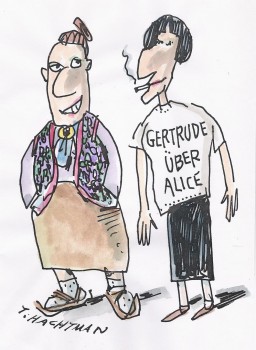
.
- The National Gallery of Portraiture is featuring a show of art about Gertrude Stein. Called Seeing Gertrude Stein: Five Stories, the show features the work of over 100 artists. Tom Hachtman, whose comic strip, Gertrude and Alice. has been an obsession of mine, is one of those artists who contributed to this show. So if you’re in D.C. look for an original piece of art by Tom. (Tomorrow, I’ll post a video of a short short I did of one of Tom’s strips.)
Go here to see one of Tom’s contributions to the exhibit.
The show just opened on Friday and runs through Jan. 22, 2012.
Commentary &Hubley &Independent Animation &John Canemaker 12 Oct 2011 06:51 am
A Hubley Affair
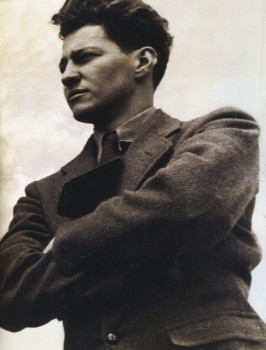 – The AMPAS program celebrating the early work of John Hubley went off wonderfully on Monday evening. The show started at 7pm, but prior to it there was a cocktail party for about 50 people. I have no idea who was invited to this, but it seemed to be Academy members who might have know the Hubleys as well as friends of the Hubley family. All four of the Hubley children were there including: Emily, her husband, Will Rosenthal, and their son, Max; Georgia and husband, Ira Kaplan (both part of the group Yo Lo Tengo); Ray Hubley, and Mark Hubley.
– The AMPAS program celebrating the early work of John Hubley went off wonderfully on Monday evening. The show started at 7pm, but prior to it there was a cocktail party for about 50 people. I have no idea who was invited to this, but it seemed to be Academy members who might have know the Hubleys as well as friends of the Hubley family. All four of the Hubley children were there including: Emily, her husband, Will Rosenthal, and their son, Max; Georgia and husband, Ira Kaplan (both part of the group Yo Lo Tengo); Ray Hubley, and Mark Hubley.
Also there, were Tissa David, Ed Smith, Candy Kugel, George Griffin, Vinnie Cafarelli, Lee Corey, Ruth Mane, John Canemaker (of course) with Joe Kennedy and others I probably have forgotten. Patrick Harrison and John Fahr ran and hosted the event for the Academy.
At the program I saw: Ray Kosarin, Linda Beck, Stephen MacQuignon, Richard O’Connor, Bill Plympton, and a hundred others that I recognized. The house was full.
As we entered the theater, prior to the start of the show, the soundtrack to Finian’s Rainbow was playing. Frank Sinatra, Ella Fitzgerald, Louis Armstrong, Ella Logan and Barry Fitzgerald.
The actual program began as all Academy events do, exactly on time. Patrick Harrison spoke for two minutes promising that next month the event would be a retrospective of the work of Saul Bass done in conjunction with MOMA. He then introduced John Canemaker, and we were off and running.
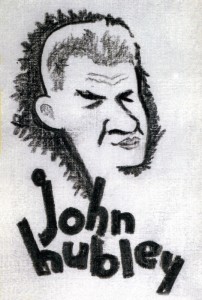 John started with a PowerPoint presentation that showed the child, John Hubley, his surly uncle who became the model for Mr. Magoo; we saw some childhood drawings as well as a number of strong influences including classmate, Alvin Lustig, who designed the UPA logo. These were followed by some of the artwork Hubley did for Disney, which included a lot of Layouts and preliminary Background sketches. We saw art done during the War as well as preliminary art for many of the UPA films. John Canemaker featured a lot of Hubley in-house cartoon drawings peppered throughout the presentation.
John started with a PowerPoint presentation that showed the child, John Hubley, his surly uncle who became the model for Mr. Magoo; we saw some childhood drawings as well as a number of strong influences including classmate, Alvin Lustig, who designed the UPA logo. These were followed by some of the artwork Hubley did for Disney, which included a lot of Layouts and preliminary Background sketches. We saw art done during the War as well as preliminary art for many of the UPA films. John Canemaker featured a lot of Hubley in-house cartoon drawings peppered throughout the presentation.
This talk ultimately led to screening the movies.
Unfortunately, it started with the only 16mm print, a soft-focus soft color print of Brotherhood of Man. Somewhere a good print of this film exists, and I don’t know when it’ll be found – hopefully in my lifetime. It’s such an enormously powerful film, designed in a style which was borrowed from Saul Steinberg‘s work at the time.
Flat Hatting followed with a beautiful 35mm print. This is a brilliantly directed film showing how much good can be done with limited animation. It never felt limited, nor does it feel like an educational film for pilots. It’s very entertaining and drew a lot of laughs. Hubley had spent years directing mediocre films under Frank Tashlin at Columbia and a number of films for the military. This film shows how much he had learned as a director in such a short time.
The Magic Fluke is probably the best of the Fox and Crow series. This film has a great sense of design featuring that famous background by Jules Engel of the concert hall. I’m not sure Hubley was best cast as the director of a lightning quick comedy cartoon, but, for the most part, it works well. The print, again, was sterling.
Following this was a beautiful print of Ragtime Bear, the first Magoo cartoon. I hadn’t remembered how fluid the animation was; there was some beautiful distortion on Magoo later in the film. My guess is that it was a Pat Mathews scene. The film offers all of Magoo’s traits, but the character design is far away from what Pete Burness ended up directing.
The cr̬me de la creme of the evening: Rooty Toot Toot followed. What a beautiful, big 35mm print. What a stunner of a scene Рthat great Grim Natwick animation of Nelly Bly Рall blue Рcorkscrewing her hands and arms in the witness chair. Beautiful and funny. This is certainly one of the great films ever created.
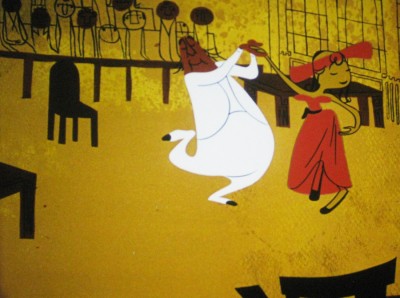
An image photographed off the screen
There were a stash of commercials – both West and East coast – from the original Storyboard Prods. I own prints of all screened except for my favorite: a spot for Mennen aftershave. A rectangle of wrinkles around a pair of eyes. Mennen helps the lines smooth out, and the commercial uses abstraction for a very funny commercial. It was the first time I’d seen this commercial. They certainly were creative back then. Hubley repeated the use of abstraction in a number of other, later spots. I’m thinking particularly of one done in the early 70s for AT&T; Tissa David animated.
Beautiful reconstructed prints from MOMA included Adventures of an * and Tender Game. One was more beautiful than the other. Both are great films.
Voyage to Next was represented with a beautiful print, though I have to say, I never really liked this film. I had a lot to do with the making of it, and it really was a challenge and a great learning experience. About a third of the way through the production money ran out, and we had a film to get out with a small but great staff. There was a lot of stylistic improvisation done to try tokeep on a vbery tight budget, while being artful. It was a tough time for the Hubleys, and they stayed true to the film at hand.
Finally, the evening ended with a beautiful animatic called Facade. These were storyboards filmed (with slates) for a William Walton and Edith Sitwell score. John Canemaker actually located and got the rights to a version with Edith Sitwell, herself, actually doing the narration. Miraculously, it all seemed well in sync. This piece was done in 1964 as a sample for PBS., though the film was never completed. A real find for Canemaker straight from the Hubley collection. A film not seen by the public (and it hasn’t made its way into animation history books, either.)
All in all the show was so invigorating that the Academy had a hard time getting rid of us. People stayed and chatted in the lobby. It was a great event.
John and Joe, Heidi and I went out for dinner so we could chat about the program. I had a blast all night; it was one of the finest animation events I’d attended in many years.
Here are pictures I took during the evening.
.
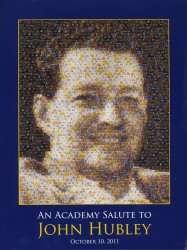
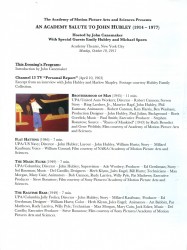 1
1
The cocktail party
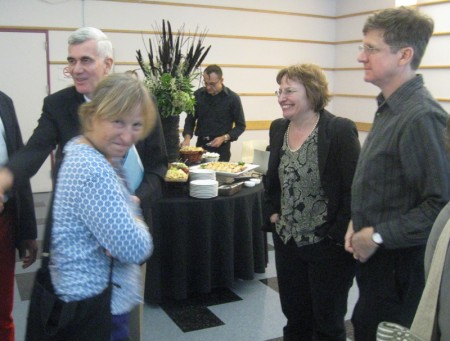 1
1
LtoR: John Canemaker, Georgia Hubley, Emily Hubley, Will Rosenthal
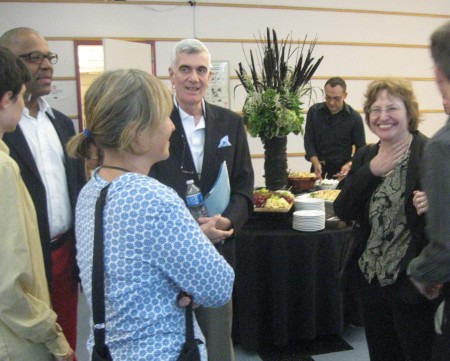 2
2
LtoR: unknown, Patrick Harrison, Georgia Hubley, John Canemaker,
unknown in rear, Emily Hubley, Will Rosenthal
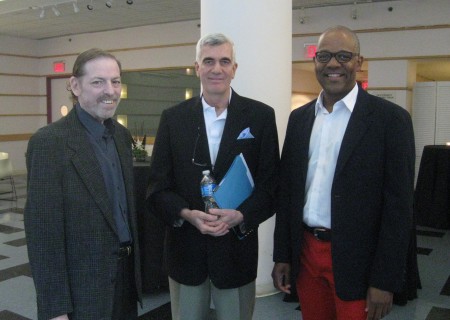 3
3
LtoR: me, John Canemaker, Patrick Harrison
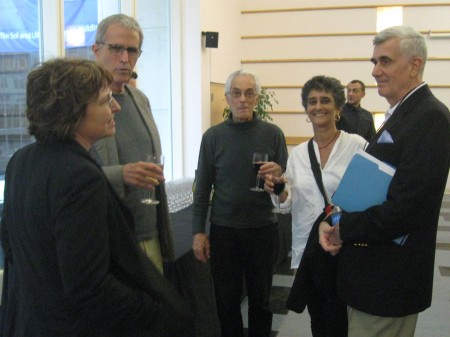 4
4
LtoR: Emily Hubley, George Griffin, Vinnie Cafarelli,
Candy Kugel, John Canemaker
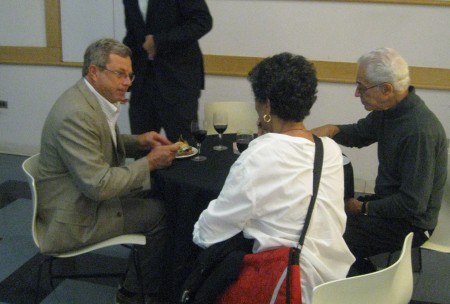 5
5
LtoR: Mark Hubley, Candy Kugel, Vinnie Cafarelli
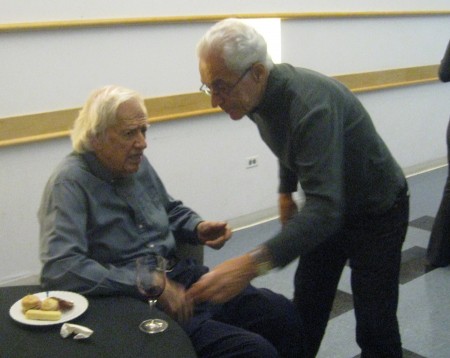 6
6
LtoR: Ed Smith, Vinnie Cafarelli
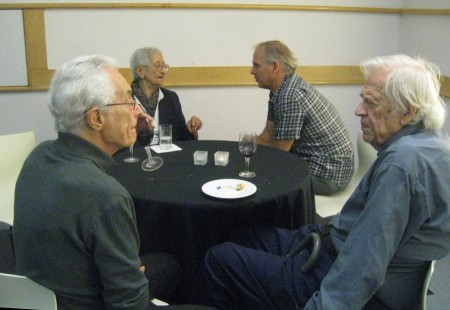 7
7
LtoR: Vinnie Cafarelli, Tissa David, Lee Corey, Ed Smith
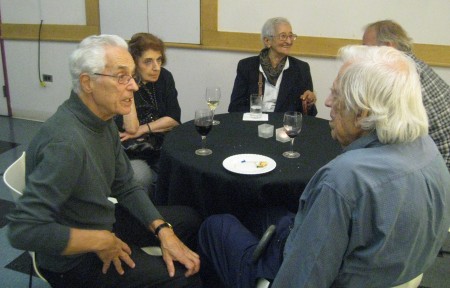 8
8
LtoR: Vinnie Cafarelli, Ruth Mane, Tissa David
Lee Corey (partially hidden), Ed Smith
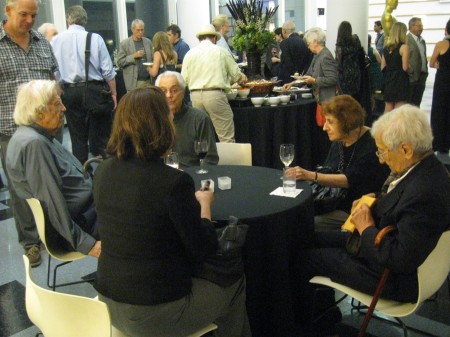 9
9
at table LtoR: Ed Smith, Heidi Stallings, Vinnie Cafarelli,
Ruth Manne, Tissa David
in rear, standing with winde glass: George Griffin w/Jeff Scher and wife, Bonnie.
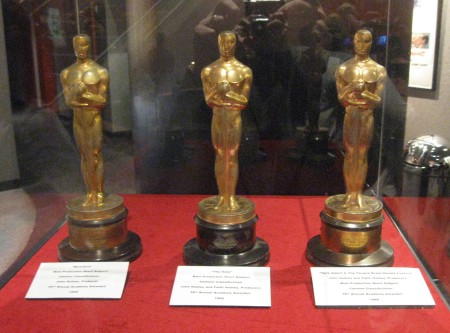 10
10
The three Hubley Oscars for (LtoR): Moonbird,
The Hole, The Tijuana Brass Double Feature.
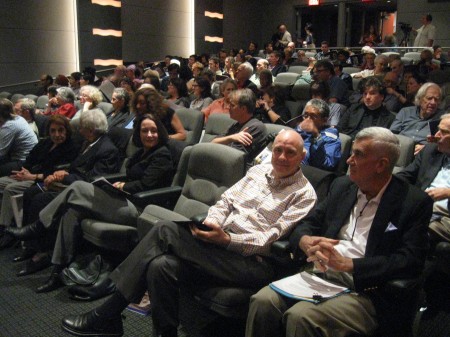 11
11
Audience front row (RtoL):
John Canemaker, Joe Kennedy, my empty seat,
Heidi Stallings, Tissa David, Ruth Mane
2nd Row, over empty seat: Stephen MacQuignon
3rd row (RtoL): Ed Smith, Richard O’Connor
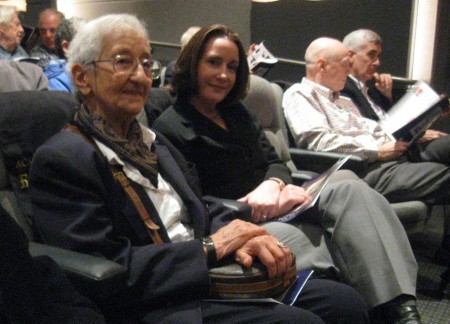 12
12
LtoR:Tissa David, Heidi Stallings, Joe Kennedy, John Canemaker
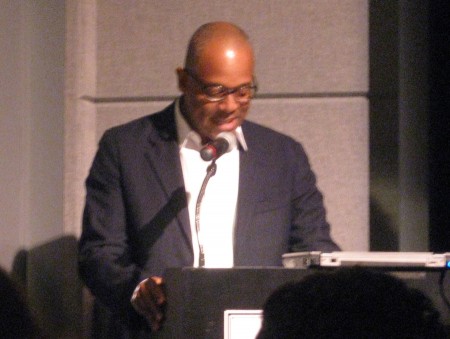 13
13
Patrick Harrison giving thanks and introducing John Canemaker.
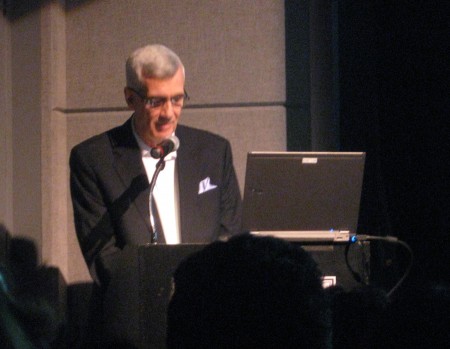 14
14
John Canemaker giving PowerPoint presentation
The following images were photograped during the PowerPoint
presentation or during the films. Consequently, they often soft focus.
With apologies.
.
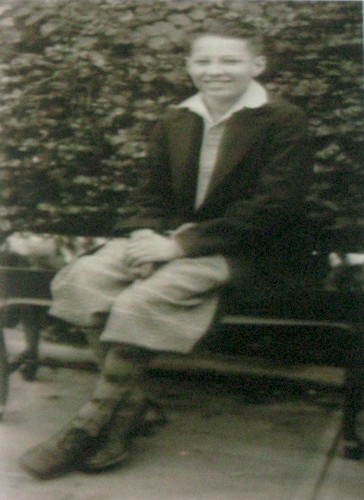 15
15A very young John Hubley
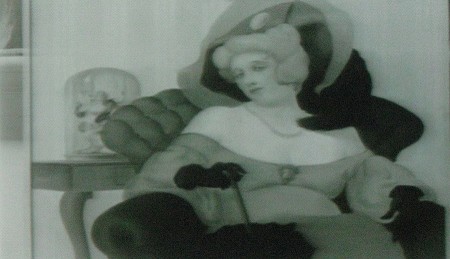 16
16
An early John Hubley painting
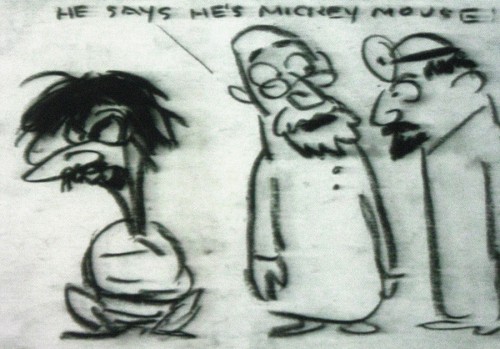 17
17
A gag cartoon from Hubley. Self portrait in straight-jacket.
Images from Facade follow:
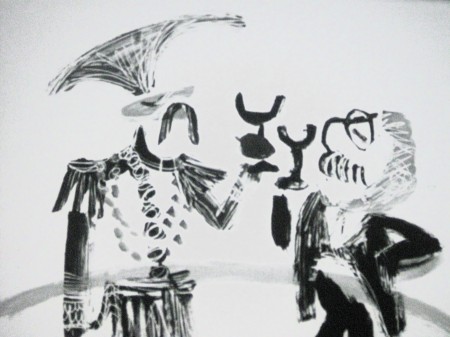 1
1
The animatic was done in 1964.
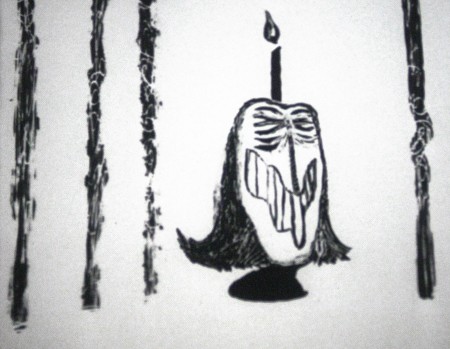 2
2
Stylistically it feels like:
Moonbird, The Hole and The Hat crushed into one.
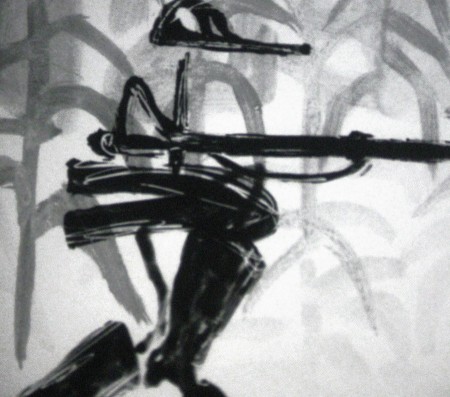 5
5
The Hat for this animated duck-like character
Toward the end of the film there was one extremely long vertical pan.
It was an oil painting done by John, beautiful in its simplicity, perfectly
planned to fill a good 45 secs to a minute of screen time and yet it
was so compositionally correct and glosiously layed out.
All I can say is that I am so pleased to have had the opportunity to have
worked with John & Faith Hubley; it was all that it could have been and more.
One of the high spots of my life.
Hubley 10 Oct 2011 08:02 am
Hubley Program
This will be the program for the Hubley show at the Academy in New York, tonight at 7pm.
I believe there many be some tickets still left for it, but check before you come.
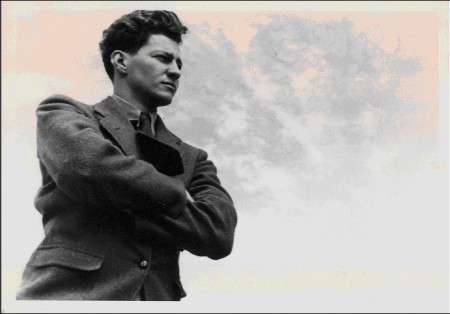
The Academy of Motion Picture Arts and Sciences presents
A SALUTE TO JOHN HUBLEY (1914-1977)
October 10, 2011
Program curated by John Canemaker and Emily Hubley
Hosted by John Canemaker
1. PERSONAL REPORT – excerpt from 10 April 1963 Channel 13 TV kinescope with John Hubley and Harlow Shapley –
film courtesy Hubley Family Collection
2. Power Point introduction by John Canemaker
3. BROTHERHOOD OF MAN (1945) (UPA/United Auto Workers) – film courtesy AMPAS
Direction: Robert Cannon
Screen Story: Ring Lardner, Jr.; Maurice Rapf; John Hubley; Phil Eastman
Animation: Robert Cannon, Ken Harris, Ben Washam
Production Design: John Hubley, Paul Julian
Background: Boris Gorelick
Music: Paul Smith
Executive Producer: Stephen Bosustow
Source: “Races of Mankind” (1943) by Ruth Benedict and Gene Weltfish
4. FLAT HATTING (1946) (UPA/US Navy) – film courtesy NARA/AMPAS
Director: John Hubley
Layout: John Hubley, William Hurtz
Story: Millard Kaufman
Voice: William Conrad]
5. THE MAGIC FLUKE (1949) (UPA/Columbia) – film courtesy Sony/AMPAS
Direction: John Hubley
Supervision: Ade Woolery
Production: Ed Gershman
Story: Sol Barzman
Music: Del Castillo
Design: Herb Klynn, Jules Engel, Bill Hurtz
Technical: Max Morgan, Mary Cain
Animation: Bob Cannon, Rudy Larriva, Willy Pyle, Pat Mathews [sic]
Executive Producer: Steve Bosustow
6. THE RAGTIME BEAR (1949) UPA/Columbia Jolly Frolics) – film courtesy Sony/AMPAS
Direction: John Hubley
Story: Millard Kaufman
Production: Ed Gershman
Design: William Hurtz
Color: Herb Klynn, Jules Engel
Animation: Art Babbitt, Pat Matthews, Rudy Larriva, Willy Pyle
Technical: Max Morgan, Mary Cain, Jack Eckes
Music: Del Castillo
Executive Producer: Steve Bosustow
7. ROOTY TOOT TOOT (1952) (UPA) – film courtesy Sony/AMPAS
(released for Oscar consideration in 1951)
Director: John Hubley
Lyrics: Allen Alch
Music: Phil Moore
Choreography: Olga Lunick
Writers: John Hubley, Bill Scott
Animation: Art Babbitt, Pat Matthews, Tom McDonald, Grim Natwick
Color and Design: Paul Julian
Technical Supervision: Sherm Glas
Production Manager: Herb Klynn
Executive Producer: Stephen Bosustow
INTERMISSION
8. TV COMMERCIAL REEL (14 spots, c. 1950s & 60s) Hubley’s Storyboard Studio – film courtesy Hubley Family Collection
Design/layout: John Hubley
Animation by various artists, including Art Babbitt, Emery Hawkins.
9. ADVENTURES OF AN ASTERIX (1957) (Hubley Studio) –
film courtesy MoMA
Design and Direction by John Hubley
Story by John Hubley and Faith Elliot
In collaboration with James Johnson Sweeney
Animation: Emery Hawkins
Assisted by Ed Smith
Film Editor Faith Elliot
Music by Benny Carter
10. THE TENDER GAME (1958) – Hubley Studio –
film courtesy MOMA
Design and Direction by John Hubley
Editing by Faith Elliot
Musical interpretation by The Oscar Peterson Trio
Vocal by Ella Fitzgerald
Animation: Ed Smith, Robert Cannon, Jack Schnerk, Emery Hawkins
11. VOYAGE TO NEXT (1974) – Hubley Studio –
film courtesy AMPAS
Directed by John Hubley
Produced by Faith Hubley
Scenario by Faith and John Hubley
Music composed and conducted by Dizzy Gillespie
Voices: Maureen Stapleton and Dizzy Gillespie
Design and backgrounds by John and Faith Hubley
Animation: Phil Duncan, Bill Liuttlejohn, Earl James.
Assisted by Michael Sporn.
12. FACADE (c. 1960s) – Hubley Studio -
35mm animatic storyboards for unfinished short of William Walton/Edith Sitwell 1927 abstract music score –
film courtesy of Hubley Family Collection
No credits available.
13. John Canemaker moderates Q&A with Emily Hubley and Michael Sporn.
